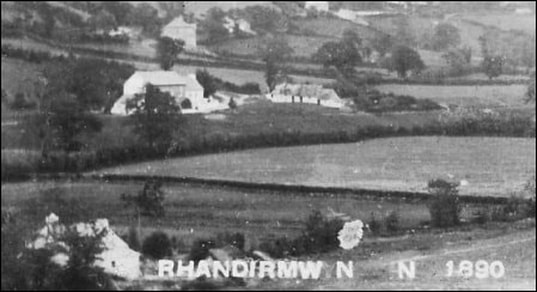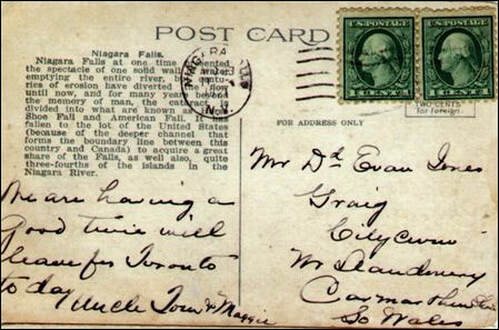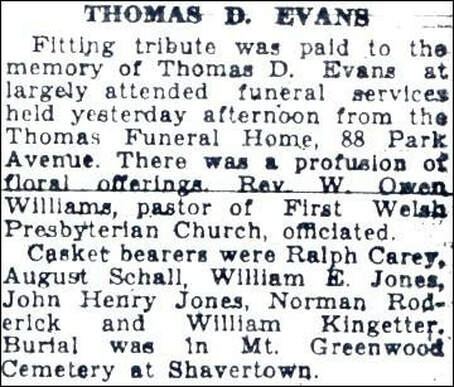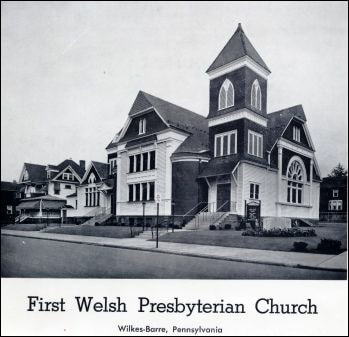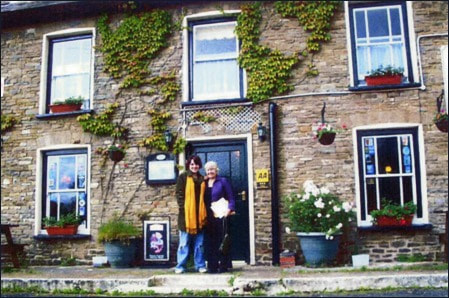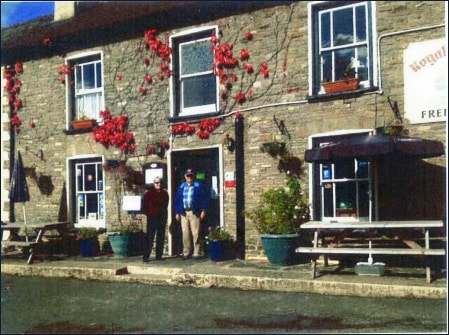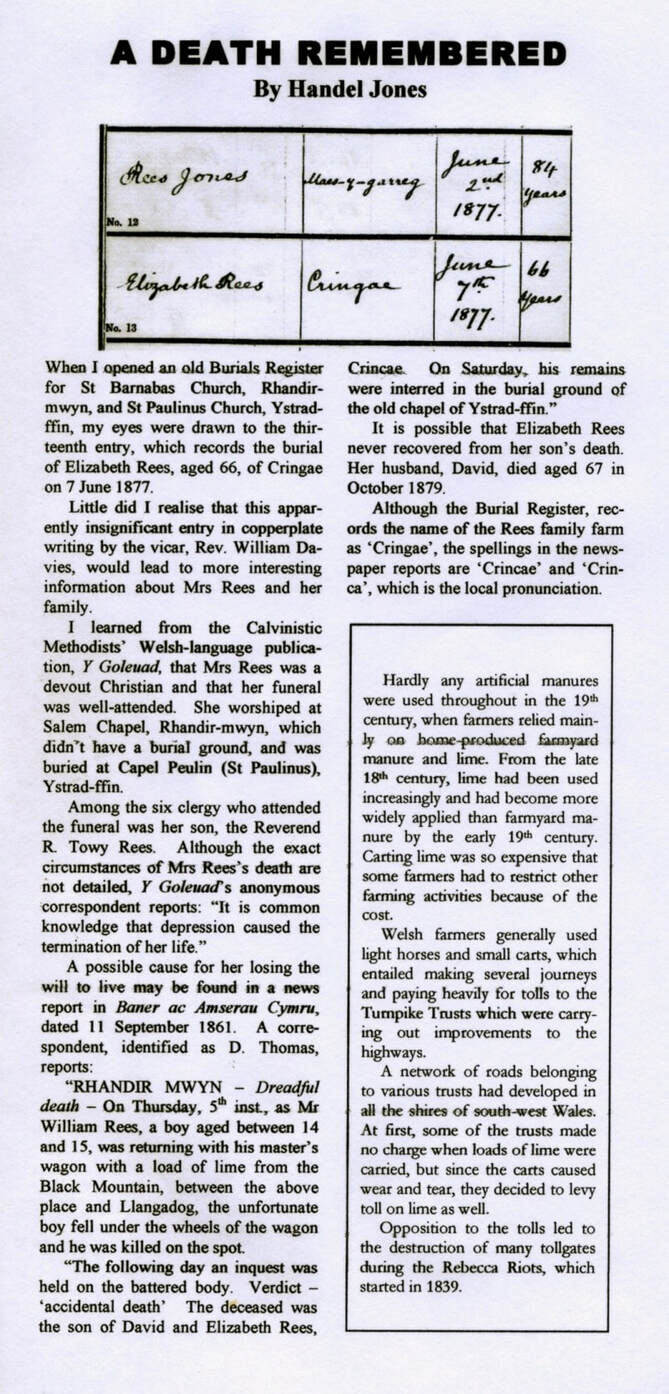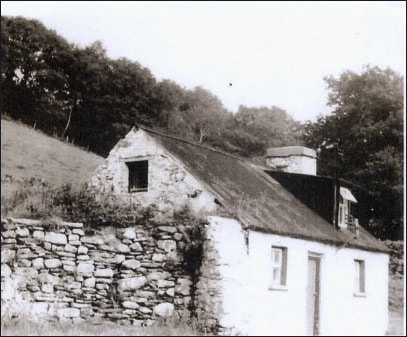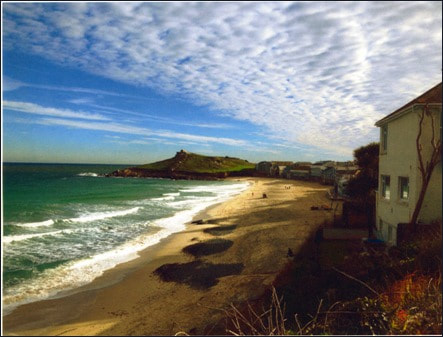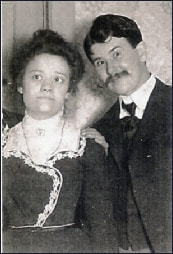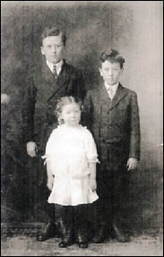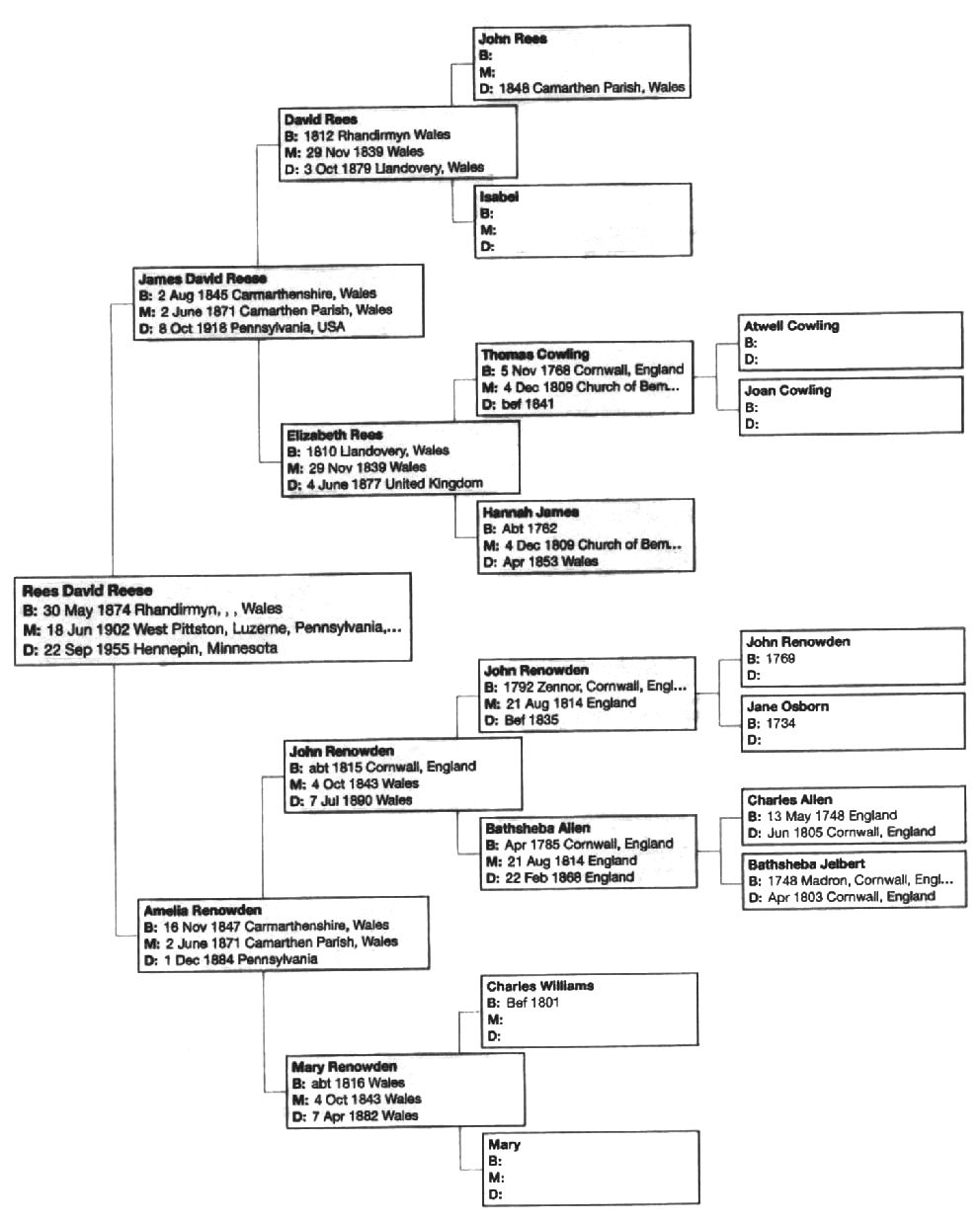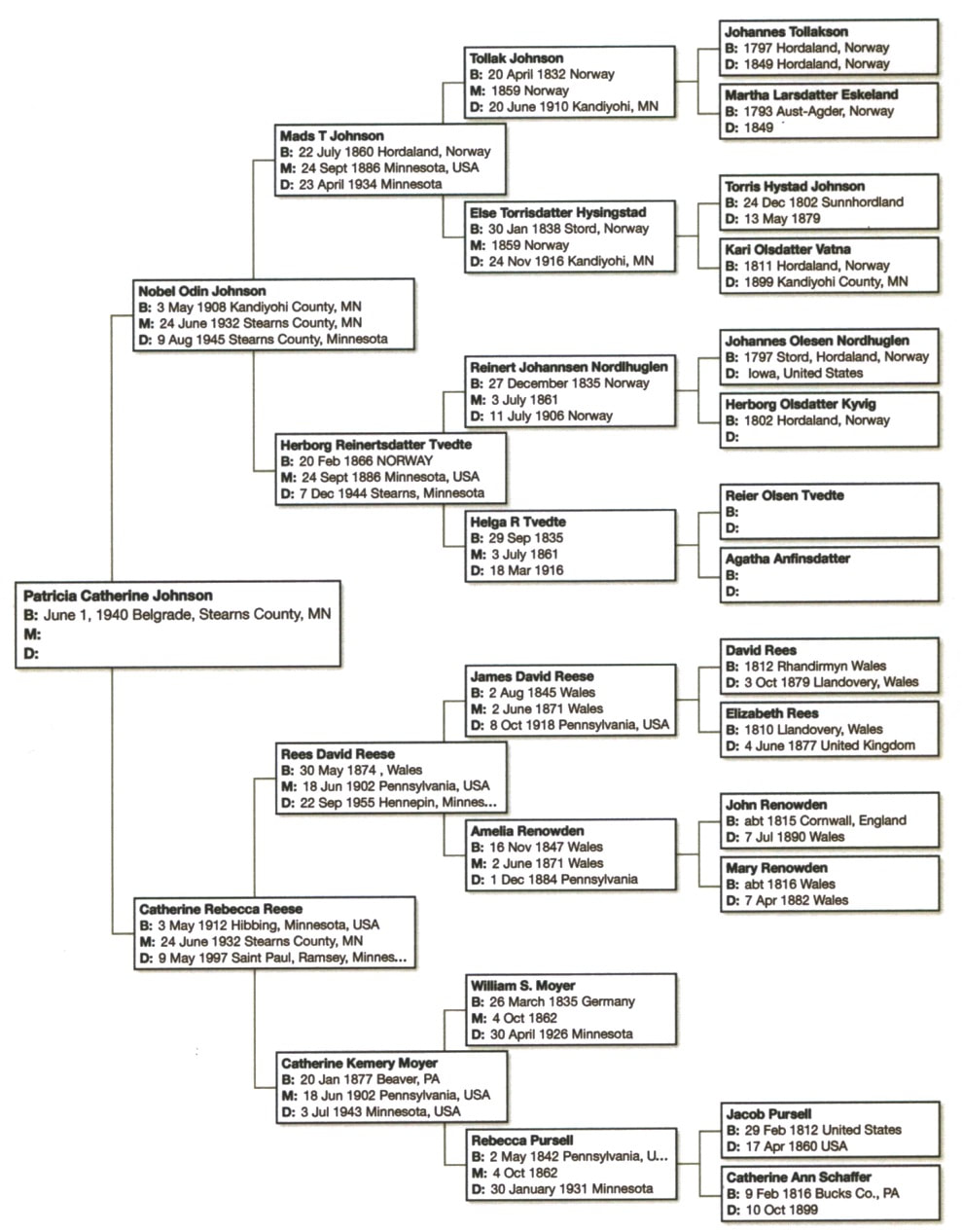CROESO
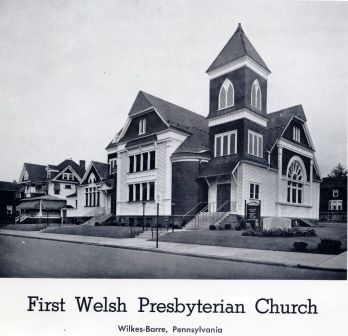
Yn fwy na thebyg rydych chi’n methu deall pam mae tudalen yn ymwneud ag America ar wefan sy’n rhoi hanes pentref bychan yng Nghymru. Mae dau air yn cysylltu Rhandir-mwyn ag America, sef ‘plwm’ a ‘sinc’. Roedd mwynwyr plwm y graig galed yn gwbl addas i weithio yng ngweithfeydd glo caled America, ac o ganol tan ddiwedd y 1800au ymadawodd llawer am fywyd gwell yn y lle rhyfeddol hwn a oedd yn llawn addewidion a golud. Fe fyddech chi’n synnu faint o bobl adawodd y dyffryn hyfryd hwn i ddechrau bywyd newydd y tu hwnt i Fôr Iwerydd. Talaith Pennsylvania oedd pen y daith i'r rhan fwyaf, yn enwedig ardaloedd glo caled Scranton a Wilkes-Barre . Aeth rhai i daleithiau eraill, fodd bynnag. Os ydych chi’n ddisgynnydd neu’n berthynas i rywun a adawodd yr ardal hon, hoffwn glywed gennych. Ydych chi’n chwilio am berthnasau a aeth i America, neu a ydych chi’n byw yno – neu rywle arall o ran hynny - ac yn chwilio am hynafiaid oedd yn hanu o Randir-mwyn neu Flaenau Tywi. Gadewch i mi gael eich hanes.
Er i lawer fynd i weithio yn y pyllau glo, aeth eraill ar drywydd gwaith arall a llwyddo’n dda. Dyma hanes rhai o’r bobl hynny. Caiff hanes eraill ei gynnwys yn y dyfodol
Er i lawer fynd i weithio yn y pyllau glo, aeth eraill ar drywydd gwaith arall a llwyddo’n dda. Dyma hanes rhai o’r bobl hynny. Caiff hanes eraill ei gynnwys yn y dyfodol
Thomas D Evans - Morgan B Williams - Renowden & Rees - John T Williams - William R Lewis & Jane ‘Jenny’ Lewis
O Randir-mwyn i Pennsylvania
Hanes Thomas D. Evans a’i deulu
Ganed Thomas D. Evans yng Ngwernhirion, Rhandir-mwyn ar 10 Mai 1864. Roedd yn fab i Daniel a Mary ac yn frawd i fy hen fam-gu, Sarah. Roedd ei dad, Daniel, yn fwynwr i gwmni gwaith plwm Nant-y-mwyn. Aeth Thomas hefyd i weithio yn y mwynglawdd pan oedd yn ifanc.
Mae Cyfrifiad 1881 yn cadarnhau hyn.
Ganed Thomas D. Evans yng Ngwernhirion, Rhandir-mwyn ar 10 Mai 1864. Roedd yn fab i Daniel a Mary ac yn frawd i fy hen fam-gu, Sarah. Roedd ei dad, Daniel, yn fwynwr i gwmni gwaith plwm Nant-y-mwyn. Aeth Thomas hefyd i weithio yn y mwynglawdd pan oedd yn ifanc.
Mae Cyfrifiad 1881 yn cadarnhau hyn.
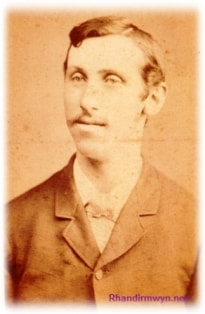
Yn 1883 priododd â Jane (nid yw’r cefndir yn hysbys eto) ac yn 1884 ganwyd eu merch, Mary Ann. Heb amheuaeth roedd bywyd yn galed ac mae’n siŵr y cawsant eu swyno gan yr holl sôn am fywyd yn y Byd Newydd. Yn y diwedd, gwnaeth y ddau benderfyniad mwyaf eu bywyd, sef ymfudo i America ynghyd â’i merch ifanc. Dychmygwch y teulu ifanc yn hwylio 3,000 milltir mewn llong fechan i wlad hollol ddieithr. Rwy’n amau a oeddynt erioed wedi gweld y môr, heb sôn am dreulio rhwng pedair a chwe wythnos ar y tonnau.
Yn 1888 cyrhaeddodd y teulu bach Ynys Ellis, Efrog Newydd, ac oddi yno aethant i Pennsylvania ac ymgartrefu yn North Mead Street, Wilkes-Barre. Roedd hon yn dref yng nghanol diwydiant glo America ac roedd Thomas yn gymwys i weithio yn y diwydiant yn sgil ei brofiad yn fwynwr yn Nant-y-mwyn. Bu’n gweithio i Gwmni Glo Red Ash a Glofa’r Empire, a oedd yn perthyn i Gwmni Glo Glen Alden, lle roedd yn fforman erbyn iddo ymddeol.
Yn 1888 cyrhaeddodd y teulu bach Ynys Ellis, Efrog Newydd, ac oddi yno aethant i Pennsylvania ac ymgartrefu yn North Mead Street, Wilkes-Barre. Roedd hon yn dref yng nghanol diwydiant glo America ac roedd Thomas yn gymwys i weithio yn y diwydiant yn sgil ei brofiad yn fwynwr yn Nant-y-mwyn. Bu’n gweithio i Gwmni Glo Red Ash a Glofa’r Empire, a oedd yn perthyn i Gwmni Glo Glen Alden, lle roedd yn fforman erbyn iddo ymddeol.
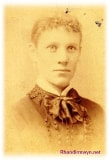
Arhosodd Thomas a’i deulu yn America am weddill eu bywydau, gan ymgartrefu yn y diwedd yn 148 South Sherman Street, Wilkes-Barre.
Does dim cofnod ohonynt yn dychwelyd i Gymru, ddim hyd yn oed ar eu gwyliau. Bu aelodau eraill o’r teulu yn byw yn America, gan gynnwys David Harris Evans (nai) a’i chwaer, Margaret. Bu fy hen fam-gu, Sarah, yn America am gyfnod ond mae’n debyg iddi ddychwelyd i Gymru.
Yn 1921 aeth Thomas ar daith i Buffalo a Rhaeadr Niagara Falls, ac o’r llefydd hyn anfonodd gardiau post at ei deulu a oedd bryd hynny yn byw yn Y Graig, Cwm Rhaeadr, Cil-y-cwm.
Does dim cofnod ohonynt yn dychwelyd i Gymru, ddim hyd yn oed ar eu gwyliau. Bu aelodau eraill o’r teulu yn byw yn America, gan gynnwys David Harris Evans (nai) a’i chwaer, Margaret. Bu fy hen fam-gu, Sarah, yn America am gyfnod ond mae’n debyg iddi ddychwelyd i Gymru.
Yn 1921 aeth Thomas ar daith i Buffalo a Rhaeadr Niagara Falls, ac o’r llefydd hyn anfonodd gardiau post at ei deulu a oedd bryd hynny yn byw yn Y Graig, Cwm Rhaeadr, Cil-y-cwm.
Ar 5 Mai 1934 bu farw Thomas, a chafodd ei gladdu gyda’i wraig a phlentyn ym Mynwent Mount Greenwood, Trucksville, Pennsylvania.
Meddai adroddiad yn y papur newydd lleol:
‘Thomas D Evans 69 of 148 South Sherman Street, died in the general hospital on Saturday afternoon. Born in Wales Mr Evans came to this country 46 years ago. For long periods he was employed at the Red Ash Coal Company and Empire Colliery of Glen Alden Coal Company. He was a member of Fidelity Lodge of Masons, Loyal Order of Moose and the Odd Fellows. A niece, Margaret Evans and a nephew David Harris Evans of Camden, New Jersey survive’.
Meddai adroddiad yn y papur newydd lleol:
‘Thomas D Evans 69 of 148 South Sherman Street, died in the general hospital on Saturday afternoon. Born in Wales Mr Evans came to this country 46 years ago. For long periods he was employed at the Red Ash Coal Company and Empire Colliery of Glen Alden Coal Company. He was a member of Fidelity Lodge of Masons, Loyal Order of Moose and the Odd Fellows. A niece, Margaret Evans and a nephew David Harris Evans of Camden, New Jersey survive’.
Cynhaliwyd y gwasanaeth angladdol yn Eglwys Bresbyteraidd Gymreig Wilkes-Barre. Yn 1997 es i Wilkes-Barre ac ymweld â’r eglwys. Cafodd ei chodi gan lowyr Cymreig. Er taw pren yw’r adeilad ar y tu allan, mae’r tu mewn yn debyg iawn i gapel Cymreig traddodiadol. Roedd yn hyfryd. Tan droad y ganrif roedd holl gofnodion yr eglwys yn Gymraeg.
Yn ddiweddarach ymwelais â Mynwent Mount Greenwood, Trucksville, a sefyll wrth ymyl bedd Thomas D Evans a’i wraig a’u plentyn. Roedd yn brofiad ingol.
Morgan B Williams
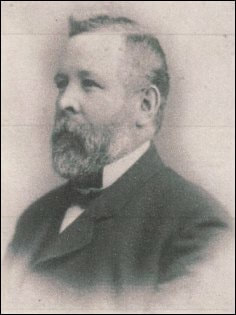
Dyma hanes y teulu Williams o Randir-mwyn. Y prif gymeriad yw Morgan B. Williams, aned yn Rhandir-mwyn ond a adawodd i chwilio am borfeydd brasach.
Yn gyntaf, aeth i Awstralia, ond wedyn aeth i America lle ymgartrefodd yn y diwedd gyda’i briod o Randir-mwyn, Catherine Armstrong Jones. Adroddir yr hanes diddorol gan William R. Williams, un o ddisgynyddion y teulu Williams o Randir-mwyn. Mae’n byw yn Ohio, UDA.
Rydym yn ddiolchgar i William (Bill) am rannu ei wybodaeth â ni.
Diolch yn fawr iawn.
Y TEULU WILLIAMS: O RANDIR-MWYN I AMERICA
MORGAN B. WILLIAMS, BACHGEN LLEOL YN LLWYDDO YN AMERICA. Byddai pennawd o'r fath yn swnio'n dda ar gyfer yr erthygl hon, ond ni fyddai'n gwneud cyfiawnder â fy nheulu Williams, a gafodd eu geni ac a fu’n gweithio ac yn byw ym mhlwyf Llanfair-ar-y-bryn cyn dod i America. Daw’r bobl hyn yn fyw wrth i mi geisio rhannu eu llawenydd a’u tristwch, llwyddiant a methiant, balchder teuluol ac ysbryd anturus wrth adael eu Cymru annwyl i chwilio am fywyd gwell ar draws Môr Iwerydd. Aethant â’u profiad mwyngloddio i Awstralia, Pennsylvania, Canada a Mecsico Newydd a buont yn canlyn crefft ac yn masnachu yno, hefyd. Rwyf i’n fab i Americanwr Cymreig o Pennsylvania a ddaeth i Toledo, Ohio, lle cyfarfu a phriodi ag Americanes Gymreig - ac mae'n naturiol fy mod yn ymfalchïo yn fy nhreftadaeth Gymreig.
Yn gyntaf, aeth i Awstralia, ond wedyn aeth i America lle ymgartrefodd yn y diwedd gyda’i briod o Randir-mwyn, Catherine Armstrong Jones. Adroddir yr hanes diddorol gan William R. Williams, un o ddisgynyddion y teulu Williams o Randir-mwyn. Mae’n byw yn Ohio, UDA.
Rydym yn ddiolchgar i William (Bill) am rannu ei wybodaeth â ni.
Diolch yn fawr iawn.
Y TEULU WILLIAMS: O RANDIR-MWYN I AMERICA
MORGAN B. WILLIAMS, BACHGEN LLEOL YN LLWYDDO YN AMERICA. Byddai pennawd o'r fath yn swnio'n dda ar gyfer yr erthygl hon, ond ni fyddai'n gwneud cyfiawnder â fy nheulu Williams, a gafodd eu geni ac a fu’n gweithio ac yn byw ym mhlwyf Llanfair-ar-y-bryn cyn dod i America. Daw’r bobl hyn yn fyw wrth i mi geisio rhannu eu llawenydd a’u tristwch, llwyddiant a methiant, balchder teuluol ac ysbryd anturus wrth adael eu Cymru annwyl i chwilio am fywyd gwell ar draws Môr Iwerydd. Aethant â’u profiad mwyngloddio i Awstralia, Pennsylvania, Canada a Mecsico Newydd a buont yn canlyn crefft ac yn masnachu yno, hefyd. Rwyf i’n fab i Americanwr Cymreig o Pennsylvania a ddaeth i Toledo, Ohio, lle cyfarfu a phriodi ag Americanes Gymreig - ac mae'n naturiol fy mod yn ymfalchïo yn fy nhreftadaeth Gymreig.
Mae’r stori’n dechrau gyda William Williams, a oedd yn rhannu f’enw ac a oedd yn Hen Hen Dad-cu i mi. Fe’i ganed tua 1801, nid yn Sir Gaerfyrddin, ond fe aeth i weithio yng ngwaith plwm yn nhrefgordd Rhandir Abad (Rhandir-mwyn). Yno, cyfarfu â merch leol, Rachel James, a phriodwyd y ddau yn Eglwys Llanfair-ar-y-bryn ar 23 Awst 1823 gan y ficer, William Morgan. Torrwyd llofnod gan William a gwnaed croes gan Rachel. Y tystion oedd Rich. Jones a Richard Morgan. Cafodd William ddyrchafiad i oruchwylio’r gwaith o glirio mwyn plwm yn Nant-y-mwyn . Addysgwyd ei blant yn ysgol Cil-y-cwm. Am eu bod yn Fethodistiaid Calfinaidd, bedyddiwyd ei ddau blentyn hynaf – Morgan, a aned 17 Medi 1831, a Mary, a aned 30 Hydref 1833, yn Nhŷ Cwrdd Cil-y-cwm . Bedyddiwyd mab arall, Daniel, a aned 8 Rhagfyr 1835, yn Salem, Capel y Methodistiaid Calfinaidd.
Erbyn Cyfrifiad 1841, roedd y teulu’n byw ym Mhentwyn, Rhandir Abad (Rhandir-mwyn) gyda’r plant a ganlyn: Morgan (9 oed); Mary (7); Daniel (5); Catherine (2), a William, fy Hen Dad-cu (4 mis). Fe allai plentyn arall fod wedi ei eni ar ôl 1828, ac wedi marw yn ei blentyndod. Y plentyn olaf oedd John, yn 1843. Pan oedd Morgan yn ei arddegau cynnar, ymunodd â’i dad yn y gwaith mwyn. Roedd iechyd ei dad yn fregus a bu farw tua 1847. Yn 16 oed, cymerodd Morgan le ei dad yn benteulu. Byddai ei frodyr, Daniel a William, yn ymuno ag ef yn y gwaith mwyn er mwyn helpu i gynnal eu mam weddw (pensiynwraig a ffermwr) a’u brodyr a chwiorydd iau.
Ailbriododd Rachel â William Theophilus a ganwyd mab, Timothy, iddynt ar 7 Tachwedd 1853. Bu farw ei hail ŵr o’i blaen hi, cyn 1861. Roedd Timothy yn gweithio yn y mwynglawdd pan oedd rhwng 12 ac 20 oed. Yn 1856 hwyliodd Morgan i Awstralia i chwilio am aur. Daeth adref yn 1861 ac yn 1862 hwyliodd i America. Teithiodd William i Awstralia yn 1864, i chwilio am aur yn Ballarat. Yno, priododd ag Elizabeth Campbell, o Glasgow yn yr Alban. Ganed tri o blant iddynt pan oeddynt yno, sef Rachel (1855), Thomas (1867) a William, fy nhad-cu, yn 1869. Ar ôl treulio bron 10 mlynedd yn Awstralia, daethant adref, cyn hwylio i America yn 1874.
Priododd Morgan â merch leol, sef Catherine, merch Joshua a Mary Armstrong Jones o Randir-mwyn. Daeth Timothy Theophilus i America yn 1873, i ymuno â’r teulu yn Wilkes-Barre, Pennsylvania. Dychwelodd am gyfnod byr i Gymru yn 1878, pan briododd â Sarah, merch Morgan a Sarah William Williams. Ynglŷn â gweddill y teulu Williams, priododd Mary â Richard Davies, mwyngloddiwr, a ganed 3 o blant iddynt, sef Miriam (1861), Elizabeth (1865) a Rachel. Pan fu farw Richard, roedd y teulu’n byw’r drws nesaf i Rachel ym Mhentwyn. Erbyn 1881, roedd Miriam yn byw gyda Mam-gu, Rachel Theophilus. Daethant i America tua 1882. Priododd Mary â dyn â'r cyfenw Lewis ac arhosodd yng Nghymru. Roedd yn dal yn fyw yn 1904, a dyna’r cyfan a wyddom amdani. Priododd Catherine â David B. Thomas. Ganed dau o feibion iddynt, sef John R. Thomas a D. V. Thomas. Daeth hithau i America, a phan oedd yn weddw priododd â David W. Evans, a oedd yn wreiddiol o Gymru. Daeth Daniel yntau i Wilkes-Barre. Ychydig a wyddys am John ar ôl 1861, pan ddywed cofnod y cyfrifiad ei fod yn 18 oed ac yn fab i fwynwr. Ni wyddys a ymfudodd ai peidio, ac ni chafodd ei restru yn ysgrif goffa ei fam yn 1887. Mae’n bosibl fod rhai o’r teulu James wedi ymfudo, ond nid oes tystiolaeth o hyn.
Erbyn Cyfrifiad 1841, roedd y teulu’n byw ym Mhentwyn, Rhandir Abad (Rhandir-mwyn) gyda’r plant a ganlyn: Morgan (9 oed); Mary (7); Daniel (5); Catherine (2), a William, fy Hen Dad-cu (4 mis). Fe allai plentyn arall fod wedi ei eni ar ôl 1828, ac wedi marw yn ei blentyndod. Y plentyn olaf oedd John, yn 1843. Pan oedd Morgan yn ei arddegau cynnar, ymunodd â’i dad yn y gwaith mwyn. Roedd iechyd ei dad yn fregus a bu farw tua 1847. Yn 16 oed, cymerodd Morgan le ei dad yn benteulu. Byddai ei frodyr, Daniel a William, yn ymuno ag ef yn y gwaith mwyn er mwyn helpu i gynnal eu mam weddw (pensiynwraig a ffermwr) a’u brodyr a chwiorydd iau.
Ailbriododd Rachel â William Theophilus a ganwyd mab, Timothy, iddynt ar 7 Tachwedd 1853. Bu farw ei hail ŵr o’i blaen hi, cyn 1861. Roedd Timothy yn gweithio yn y mwynglawdd pan oedd rhwng 12 ac 20 oed. Yn 1856 hwyliodd Morgan i Awstralia i chwilio am aur. Daeth adref yn 1861 ac yn 1862 hwyliodd i America. Teithiodd William i Awstralia yn 1864, i chwilio am aur yn Ballarat. Yno, priododd ag Elizabeth Campbell, o Glasgow yn yr Alban. Ganed tri o blant iddynt pan oeddynt yno, sef Rachel (1855), Thomas (1867) a William, fy nhad-cu, yn 1869. Ar ôl treulio bron 10 mlynedd yn Awstralia, daethant adref, cyn hwylio i America yn 1874.
Priododd Morgan â merch leol, sef Catherine, merch Joshua a Mary Armstrong Jones o Randir-mwyn. Daeth Timothy Theophilus i America yn 1873, i ymuno â’r teulu yn Wilkes-Barre, Pennsylvania. Dychwelodd am gyfnod byr i Gymru yn 1878, pan briododd â Sarah, merch Morgan a Sarah William Williams. Ynglŷn â gweddill y teulu Williams, priododd Mary â Richard Davies, mwyngloddiwr, a ganed 3 o blant iddynt, sef Miriam (1861), Elizabeth (1865) a Rachel. Pan fu farw Richard, roedd y teulu’n byw’r drws nesaf i Rachel ym Mhentwyn. Erbyn 1881, roedd Miriam yn byw gyda Mam-gu, Rachel Theophilus. Daethant i America tua 1882. Priododd Mary â dyn â'r cyfenw Lewis ac arhosodd yng Nghymru. Roedd yn dal yn fyw yn 1904, a dyna’r cyfan a wyddom amdani. Priododd Catherine â David B. Thomas. Ganed dau o feibion iddynt, sef John R. Thomas a D. V. Thomas. Daeth hithau i America, a phan oedd yn weddw priododd â David W. Evans, a oedd yn wreiddiol o Gymru. Daeth Daniel yntau i Wilkes-Barre. Ychydig a wyddys am John ar ôl 1861, pan ddywed cofnod y cyfrifiad ei fod yn 18 oed ac yn fab i fwynwr. Ni wyddys a ymfudodd ai peidio, ac ni chafodd ei restru yn ysgrif goffa ei fam yn 1887. Mae’n bosibl fod rhai o’r teulu James wedi ymfudo, ond nid oes tystiolaeth o hyn.
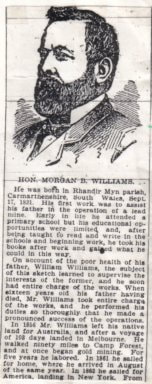
Bydd f’erthygl nesaf yn ymwneud â’r teulu Williams yn America, ynghyd ag ysgrifau coffa a fydd yn cynnwys gwybodaeth helaeth am William a Morgan, a fu’n llwyddiannus iawn yn America. Dechreuodd Morgan weithio fel mwyngloddiwr, a daeth yn berchennog mwynglawdd ynghyd â buddiannau mewn mwynglawdd graffit yng Nghanada. Roedd yn weithgar gyda’r Eglwys Bresbyteraidd Gymraeg (cyfrannodd $5000 tuag at y gost o’i hailadeiladu). Roedd yn hoff o gerddoriaeth, roedd ganddo lais canu da ac roedd yn aelod o’r Heights Glee Club pan oedd yn ddyn ifanc. Cyfranogodd ym mhob agwedd ar fywyd cymunedol a llywodraethol a bu’n gwasanaethu yn Senedd Talaith Pennsylvania a Thŷ’r Cynrychiolwyr yn America. Yn ôl yr hanes, pan glywodd perthnasau yng Nghymru ei fod yn bwriadu ‘rhedeg am swydd’, dywedodd un ohonyn nhw ei fod yn rhy dew i redeg. Pan oedd yn aelod o'r Cynulliad, cefnogodd fesur i orfodi cwmnïau glofaol i dalu cyflogau bob pythefnos, a chefnogodd fesur dros gael gwared â siopau cyflogwyr. Mewn bywgraffiad ohono gan H.C. Bradby yn 1893, dywedir, “Mr Williams has become one of the most successful and influential Welshmen in the State of Pennsylvania.”
Fy Hen Dad-cu, William J. P. Williams, oedd y person mwyaf anturus. Cymerodd ei deulu o Awstralia, i Pennsylvania ac yna i Oklahoma lle'r oedd ganddo ransh wartheg ac i Fecsico newydd lle bu’n oruchwyliwr glofa, cyn dychwelyd i Pennsylvania. Daeth yn oruchwyliwr Williams Coal Co. of Pottsville (Morgan's Co) ac wedyn yn oruchwyliwr mwynglawdd graffit yng Nghanada (Morgans hefyd) ac yn ôl unwaith eto i Wilkes-Barre, Pennsylvania. Yn ystod Streic Fawr y Golwyr yn 1876, ef oedd Llywydd Cymdeithas Glowyr Wilkes-Barre. Yn ddiweddarach, bu’n berchen ar siop gigydd, yn dosbarthu ffrwydron i fwyn gloddiau ac yn gontractwr mwyngloddio. Yn ystod contract o’r fath, fe’i lladdwyd yn 1904 pan gwympodd darn o graig o do mwynglawdd. Gobeithio, gyda’r holl enwau hyn sy’n gysylltiedig â Rhandir-mwyn y bydd modd cael hyd i ragor o gysylltiadau. Efallai y gall rhai o drigolion hynaf Rhandir-mwyn wneud y cysylltiadau hyn.
Bydd yr ail ran yn ymwneud â’r teulu Williams yn America. Alun, yn fwy na thebyg, ni fyddaf byth yn ymweld â Chymru, ond mae’n rhoi boddhad i mi feddwl y bydd yr hyn ysgrifennais yn help i ddod â’r teulu Williams yn ôl i Randir-mwyn.
William R. Williams ('R' am Rowland, sef cyfenw cyn priodi fy Mam-gu ar ochr fy nhad, o Ogledd Cymru).
Fy Hen Dad-cu, William J. P. Williams, oedd y person mwyaf anturus. Cymerodd ei deulu o Awstralia, i Pennsylvania ac yna i Oklahoma lle'r oedd ganddo ransh wartheg ac i Fecsico newydd lle bu’n oruchwyliwr glofa, cyn dychwelyd i Pennsylvania. Daeth yn oruchwyliwr Williams Coal Co. of Pottsville (Morgan's Co) ac wedyn yn oruchwyliwr mwynglawdd graffit yng Nghanada (Morgans hefyd) ac yn ôl unwaith eto i Wilkes-Barre, Pennsylvania. Yn ystod Streic Fawr y Golwyr yn 1876, ef oedd Llywydd Cymdeithas Glowyr Wilkes-Barre. Yn ddiweddarach, bu’n berchen ar siop gigydd, yn dosbarthu ffrwydron i fwyn gloddiau ac yn gontractwr mwyngloddio. Yn ystod contract o’r fath, fe’i lladdwyd yn 1904 pan gwympodd darn o graig o do mwynglawdd. Gobeithio, gyda’r holl enwau hyn sy’n gysylltiedig â Rhandir-mwyn y bydd modd cael hyd i ragor o gysylltiadau. Efallai y gall rhai o drigolion hynaf Rhandir-mwyn wneud y cysylltiadau hyn.
Bydd yr ail ran yn ymwneud â’r teulu Williams yn America. Alun, yn fwy na thebyg, ni fyddaf byth yn ymweld â Chymru, ond mae’n rhoi boddhad i mi feddwl y bydd yr hyn ysgrifennais yn help i ddod â’r teulu Williams yn ôl i Randir-mwyn.
William R. Williams ('R' am Rowland, sef cyfenw cyn priodi fy Mam-gu ar ochr fy nhad, o Ogledd Cymru).
Y TEULU WILLIAMS YN AMERICA
Treuliodd Rachel (James) Williams Theophilus bum mlynedd olaf ei bywyd yn Nanticoke, Pennsylvania, gyda’i merch, Catherine a’i hail ŵr, David W. Evans, a oedd yn fforman gyda Chwmni Glo Susquehanna am 22 blynedd. Bu farw Rachel ar 28 Awst 1887. Fel llawer o aelodau eraill y teulu, fe’i claddwyd ym mynwent Hollenback ar ôl gwasanaeth yn yr Eglwys Bresbyteraidd Gymraeg. Bu farw ei merch, Catherine yn 66 oed yn 1903, gan adael dau fab, sef John R. Thomas a’r Cynghorydd D. V. Thomas. Priododd Miriam Davies, wyres Rachel, â Wm. J. Davies, a bu iddynt dri o blant, sef Mary, Emily a Miriam. Bu farw yn 38 oed wrth roi genedigaeth. Bu farw Morgan yn 1903 a William yn 1904. Roedd brawd Morgan, Daniel yn adeiladydd a chontractwr yn Scranton, Pennsylvania. Roedd eu hanner brawd, Timothy Theophilus, yn gontractwr twnelau a gwasanaethodd sawl tymor yn Gynghorydd. Dychwelodd i Gymru, priododd ferch o Randir-mwyn ac aeth yn ôl i America.
Byddai Morgan B. Williams, y mab hynaf yn dyrchafu ei hun o fod yn löwr i fod yn berchennog glofa, yn Seneddwr Talaith ac yn aelod o Dŷ’r Cynrychiolwyr. Ei wraig gyntaf oedd Catherine, merch Joshua a Mary Armstrong Jones o Randir-mwyn, a bu iddynt dri o blant, sef Mary (Mrs. T.H. Griffiths), Rachel (Mrs. J.H. Williams o Scranton) a Benjamin F. Ail wraig Morgan B. Williams oedd Mrs. Mary Edwards Davies, a bu iddynt un mab, sef William. Mae’r ysgrif goffa sydd ynghlwm yn llawn canmoliaeth iddo.
Ganed tri phlentyn cyntaf Wm. J.P. Williams (Thomas, Rachel a William) yn Awstralia. Eu tad oedd brawd ieuengaf Morgan. Dychwelodd Wm. J.P. Williams i Fecsico Newydd sawl gwaith. Ganed ei fab Daniel yn Pennsylvania a mab arall, Morgan, yn Mecsico Newydd. Pan oedd yn Mecsico Newydd, priododd ei ferch, Rachel, a oedd yn athrawes, ag Ed. Edleman, siryf, ac arhosodd yno pan ddychwelodd y teulu i Pennsylvania. Bu farw yn 1902. Lladdwyd William pan fu cwymp mewn mwynglawdd yn 1904. Mae ei ysgrif goffa yntau yn helaeth. Bu farw ei weddw (Hen Fam-gu) tua 1924. Ni wyddys fawr ddim am y meibion Morgan a Thomas, a fu’n aelod o’r Bwrdd Archwilio Glofaol. .
Ei fab William P (g.1869) oedd fy nhad-cu, a fu’n ddofwr ceffylau pan oedd yn ifanc ac yn sgowt yn Oklahoma cyn i’r teulu ddychwelyd i Pennsylvania. Bu’n gwasanaethu ar fwrdd llong ryfel, yr ‘USS Indiana’ yn ystod y rhyfel rhwng Sbaen a’r Unol Daleithiau ac arwisgwyd ef am ddewrder yn ystod Brwydr Bae Santiago. Tua hanner can mlynedd yn ddiweddarach, roeddwn innau’n gwasanaethu ar fwrdd y llong ryfel ‘USS Wisconsin’ yn ystod Rhyfel Corea.) Ar ôl gadael y Llynges, cyfarfu â fy Mam-gu, Ellen Rowland, (g.1877) a oedd wedi gadael Gogledd Cymru yn 10 oed. Bu William P. yn gweithio i’w dad ac yn cario ffrwydron i’r mwyngloddiau â cheffyl a chert. Yn ystod eu carwriaeth, fe’i cymerodd hi gydag ef yn ystod un o’i deithiau â ffrwydron. Mae’n amlwg fod Mam-gu yn ddynes nodedig.
Symudodd y teulu o Wilkes-Barre i Kingston. (Yn anffodus, cafodd eu holl luniau eu dinistrio mewn llif). Roedd ganddynt dri o blant: William, (g.1900) Sydney, fy nhad (g.1902) ac Ellen (g. 1916). Yn y 1920au cynnar, daeth fy nhad i Ohio lle agorodd siop fwydydd yn Toledo. Un diwrnod, daeth William J. Hughes, saer, at y cownter a darganfu’r ddau eu bod yn rhannu etifeddiaeth Gymreig. Roedd teulu Mr Hughes yn dod o Benderyn ac roedd teulu ei wraig, Ursula Morgan, wedi dod o Forgannwg, yn 1872, i Jackson County, Ohio. Roedd e’n dal i ddarllen ei Feibl Cymraeg. Gwahoddwyd Pops i gapel y Methodistiaid ac i ginio dydd Sul. Mae’n werth nodi fod gan fy nhad-cu chwe merch, dwy ohonynt o oed priodi. Priododd fy nhad a fy mam, Anna Hughes (g.1906) yn 1928 (Toledo, Ohio). Roedd gan f'ewythr Bill, plymwr, (g.1900) a’i wraig Martha un ferch, Margaret, a briododd â Raymond Dukinas. Bu farw Wncwl Bill yn 1977. Priododd fy modryb Ellen (g.1916) â William Nast o Kingston, ac roedd ganddynt dri mab, sef William a gefeilliaid, Richard a Robert.
Modryb Ellen oedd yr aelod olaf o deulu fy nhad. Roedd yn rhannu fy niddordeb mewn coeden deulu a bu o gymorth mawr i mi. Bu farw yn 2003. Bu farw fy mam yn 1970 yn 64 oed, a bu farw fy nhad yn 1978 yn 76 oed.. Bu farw Dad-cu Wm yn 1945 yn 76 oed a Mam-gu Ellen yn 1971 yn 94 oed. Roedd Tad-cu Hughes yn 91 oed pan fu farw yn 1962. Teimlaf fy mod wedi helpu’r teulu Williams i gwblhau cylchdro o ddwy ganrif a dod adref unwaith eto i Gymru. Byddaf yn dal i chwilio am ragor o berthnasau yng Nghymru a Pennsylvania. Mae’n debyg fod Hen Hen Dad-cu William wedi marw ym mis Mawrth 1847, ond ni chefais unrhyw lwyddiant yn dod o hyd i dystysgrif marwolaeth na man claddu. Gallai cael hyd i fan ei eni ddatgelu pwy oedd ei rieni. Hefyd, hoffwn wybod beth ddigwyddodd i Mary a John Williams a chael gwybodaeth am y teulu James er mwyn ychwanegu pennod arall.
Cofion William R. Williams (Bill)
Annwyl ddarllenwyr, byddwch cystal â derbyn f’ymddiheuriadau os wyf heb gynnwys rhywun. Wrth i’r goeden dyfu, mae’n mynd yn anos dal i fyny â’r holl ychwanegiadau.
OS OES GENNYCH YCHWANEGIAD AT EIN COEDEN DEULU, A FYDDECH CYSTAL Â THROSGLWYDDO’R WYBODAETH I MI.
Gallwch adael unrhyw wybodaeth ar ein tudalen i westeion neu wrth gysylltu â ni trwy e-bost [email protected] a throsglwyddwn yr wybodaeth honno i William (Bill) Williams.
Any information please leave on our guestbook page or contact us via e.mail [email protected]t and we will pass on any information to William (Bill) Williams.
Byddai Morgan B. Williams, y mab hynaf yn dyrchafu ei hun o fod yn löwr i fod yn berchennog glofa, yn Seneddwr Talaith ac yn aelod o Dŷ’r Cynrychiolwyr. Ei wraig gyntaf oedd Catherine, merch Joshua a Mary Armstrong Jones o Randir-mwyn, a bu iddynt dri o blant, sef Mary (Mrs. T.H. Griffiths), Rachel (Mrs. J.H. Williams o Scranton) a Benjamin F. Ail wraig Morgan B. Williams oedd Mrs. Mary Edwards Davies, a bu iddynt un mab, sef William. Mae’r ysgrif goffa sydd ynghlwm yn llawn canmoliaeth iddo.
Ganed tri phlentyn cyntaf Wm. J.P. Williams (Thomas, Rachel a William) yn Awstralia. Eu tad oedd brawd ieuengaf Morgan. Dychwelodd Wm. J.P. Williams i Fecsico Newydd sawl gwaith. Ganed ei fab Daniel yn Pennsylvania a mab arall, Morgan, yn Mecsico Newydd. Pan oedd yn Mecsico Newydd, priododd ei ferch, Rachel, a oedd yn athrawes, ag Ed. Edleman, siryf, ac arhosodd yno pan ddychwelodd y teulu i Pennsylvania. Bu farw yn 1902. Lladdwyd William pan fu cwymp mewn mwynglawdd yn 1904. Mae ei ysgrif goffa yntau yn helaeth. Bu farw ei weddw (Hen Fam-gu) tua 1924. Ni wyddys fawr ddim am y meibion Morgan a Thomas, a fu’n aelod o’r Bwrdd Archwilio Glofaol. .
Ei fab William P (g.1869) oedd fy nhad-cu, a fu’n ddofwr ceffylau pan oedd yn ifanc ac yn sgowt yn Oklahoma cyn i’r teulu ddychwelyd i Pennsylvania. Bu’n gwasanaethu ar fwrdd llong ryfel, yr ‘USS Indiana’ yn ystod y rhyfel rhwng Sbaen a’r Unol Daleithiau ac arwisgwyd ef am ddewrder yn ystod Brwydr Bae Santiago. Tua hanner can mlynedd yn ddiweddarach, roeddwn innau’n gwasanaethu ar fwrdd y llong ryfel ‘USS Wisconsin’ yn ystod Rhyfel Corea.) Ar ôl gadael y Llynges, cyfarfu â fy Mam-gu, Ellen Rowland, (g.1877) a oedd wedi gadael Gogledd Cymru yn 10 oed. Bu William P. yn gweithio i’w dad ac yn cario ffrwydron i’r mwyngloddiau â cheffyl a chert. Yn ystod eu carwriaeth, fe’i cymerodd hi gydag ef yn ystod un o’i deithiau â ffrwydron. Mae’n amlwg fod Mam-gu yn ddynes nodedig.
Symudodd y teulu o Wilkes-Barre i Kingston. (Yn anffodus, cafodd eu holl luniau eu dinistrio mewn llif). Roedd ganddynt dri o blant: William, (g.1900) Sydney, fy nhad (g.1902) ac Ellen (g. 1916). Yn y 1920au cynnar, daeth fy nhad i Ohio lle agorodd siop fwydydd yn Toledo. Un diwrnod, daeth William J. Hughes, saer, at y cownter a darganfu’r ddau eu bod yn rhannu etifeddiaeth Gymreig. Roedd teulu Mr Hughes yn dod o Benderyn ac roedd teulu ei wraig, Ursula Morgan, wedi dod o Forgannwg, yn 1872, i Jackson County, Ohio. Roedd e’n dal i ddarllen ei Feibl Cymraeg. Gwahoddwyd Pops i gapel y Methodistiaid ac i ginio dydd Sul. Mae’n werth nodi fod gan fy nhad-cu chwe merch, dwy ohonynt o oed priodi. Priododd fy nhad a fy mam, Anna Hughes (g.1906) yn 1928 (Toledo, Ohio). Roedd gan f'ewythr Bill, plymwr, (g.1900) a’i wraig Martha un ferch, Margaret, a briododd â Raymond Dukinas. Bu farw Wncwl Bill yn 1977. Priododd fy modryb Ellen (g.1916) â William Nast o Kingston, ac roedd ganddynt dri mab, sef William a gefeilliaid, Richard a Robert.
Modryb Ellen oedd yr aelod olaf o deulu fy nhad. Roedd yn rhannu fy niddordeb mewn coeden deulu a bu o gymorth mawr i mi. Bu farw yn 2003. Bu farw fy mam yn 1970 yn 64 oed, a bu farw fy nhad yn 1978 yn 76 oed.. Bu farw Dad-cu Wm yn 1945 yn 76 oed a Mam-gu Ellen yn 1971 yn 94 oed. Roedd Tad-cu Hughes yn 91 oed pan fu farw yn 1962. Teimlaf fy mod wedi helpu’r teulu Williams i gwblhau cylchdro o ddwy ganrif a dod adref unwaith eto i Gymru. Byddaf yn dal i chwilio am ragor o berthnasau yng Nghymru a Pennsylvania. Mae’n debyg fod Hen Hen Dad-cu William wedi marw ym mis Mawrth 1847, ond ni chefais unrhyw lwyddiant yn dod o hyd i dystysgrif marwolaeth na man claddu. Gallai cael hyd i fan ei eni ddatgelu pwy oedd ei rieni. Hefyd, hoffwn wybod beth ddigwyddodd i Mary a John Williams a chael gwybodaeth am y teulu James er mwyn ychwanegu pennod arall.
Cofion William R. Williams (Bill)
Annwyl ddarllenwyr, byddwch cystal â derbyn f’ymddiheuriadau os wyf heb gynnwys rhywun. Wrth i’r goeden dyfu, mae’n mynd yn anos dal i fyny â’r holl ychwanegiadau.
OS OES GENNYCH YCHWANEGIAD AT EIN COEDEN DEULU, A FYDDECH CYSTAL Â THROSGLWYDDO’R WYBODAETH I MI.
Gallwch adael unrhyw wybodaeth ar ein tudalen i westeion neu wrth gysylltu â ni trwy e-bost [email protected] a throsglwyddwn yr wybodaeth honno i William (Bill) Williams.
Any information please leave on our guestbook page or contact us via e.mail [email protected]t and we will pass on any information to William (Bill) Williams.
Renowden and Rees Family of Rhandirmwyn
This is a very personal story by Pat Schumacher accounting her search for her family roots. Pat lives in Florida, USA but Rhandirmwyn has become virtually her second home as much of her family history and memories are embedded in these beautiful hills. Her ancestors emigrated to America in 1882, sailing from Liverpool. The journey started in tragic circumstances as one of their children was burnt to death in Liverpool shortly before embarking on the arduous journey across the Atlantic.
Thank you Pat for sharing the information and story.
I must also add a note of gratitude to the Renowden family as my late mother moved to Rhandirmwyn in 1927 at the age of 14 from the Swansea valley to work for William and Sarah Renowden at the Royal Oak public house. I have no doubt that it was there she met my father who had been born in the village. The rest is history.
Alun Jones
Thank you Pat for sharing the information and story.
I must also add a note of gratitude to the Renowden family as my late mother moved to Rhandirmwyn in 1927 at the age of 14 from the Swansea valley to work for William and Sarah Renowden at the Royal Oak public house. I have no doubt that it was there she met my father who had been born in the village. The rest is history.
Alun Jones
Renowden and Rees: An Introductions
My research into the Welsh branch of the family brought many surprises: for one, the ancestors were as much Cornish as Welsh in heritage. The Cornish people moved back and forth, by sea, between the very southwestern-most part of England to Wales for work in the mines. Their mining skills were highly sought after in times when Wales needed more skilled workers. Marriage was common among the Welsh and Cornish families and, as it turns out, we are as much Cornish as Welsh.
That said, the connection between the Cornish people and the Welsh people is stronger than geography. They are both of Celtic origin, and both were pushed back when the Normans invaded England. Their native languages are similar in origin.
Rhandirmwyn, the birthplace of my grandfather, Rees Reese, is a small village nestled in the Cambrian Mountains. Lead mining has been the major employer in the village for centuries, some say back to Roman times (400 A.D.). Initially, it was part of a fiefdom owned by the British Lord Cawdor. The countryside has an ancient history, some say going back to Merlin who, it is said, lived in a cave in the mountains nearby.
The Reese name is of Welsh origin, originally spelled Rhys, then Rees, then Reese. In feudal times, there were famous warriors named Rhys. Tracing family from the ancient times to the present, with a very common Welsh name, proved impossible. I was only able to find definite family links going back to the late 1700’s. Using the same first and last names is a common practice, hence my grandfather’s name, Rees David Reese. His first name uses the older form, while the surname changed permanently to add an “e” to the end, when the family immigrated to America.
Renowdens were an interesting study. They came to Wales from Cornwall and go back much further, to the early 1700’s in England. The have migrated to Australia as well as America. There are fewer Renowdens left in England now, and none in Wales that I found.
That said, the connection between the Cornish people and the Welsh people is stronger than geography. They are both of Celtic origin, and both were pushed back when the Normans invaded England. Their native languages are similar in origin.
Rhandirmwyn, the birthplace of my grandfather, Rees Reese, is a small village nestled in the Cambrian Mountains. Lead mining has been the major employer in the village for centuries, some say back to Roman times (400 A.D.). Initially, it was part of a fiefdom owned by the British Lord Cawdor. The countryside has an ancient history, some say going back to Merlin who, it is said, lived in a cave in the mountains nearby.
The Reese name is of Welsh origin, originally spelled Rhys, then Rees, then Reese. In feudal times, there were famous warriors named Rhys. Tracing family from the ancient times to the present, with a very common Welsh name, proved impossible. I was only able to find definite family links going back to the late 1700’s. Using the same first and last names is a common practice, hence my grandfather’s name, Rees David Reese. His first name uses the older form, while the surname changed permanently to add an “e” to the end, when the family immigrated to America.
Renowdens were an interesting study. They came to Wales from Cornwall and go back much further, to the early 1700’s in England. The have migrated to Australia as well as America. There are fewer Renowdens left in England now, and none in Wales that I found.
NOTES ON RESEARCH AND TRAVEL TO WALES AND CORNWALL
I visited Wales three times: the first in 1974, with husband Kay Schumacher. I had in hand a very old picture from my grandfather, of a building that I believed was in Wales. We stayed in a bed and breakfast in Llandovery, Wales, the nearest large town to the village of Rhandirmwyn where my grandfather was born. That evening in the lodge, I passed the picture around to other guests. One man, a salesman, immediately recognized the building as the pub in the middle of Rhandirmwyn, and he said we would have no trouble finding it the next morning.
Rhandirmwyn is about seven miles from Llandovery but the road climbs into the mountains; it is winding and narrow, with hedgerows along the edges. Meeting cars (while on the left side of the road) is formidable. Just as the salesman told us, the pub dominates the village. The Royal Oak Inn is a solid stone building, larger than most other buildings, at the top of a hill and right off the road that winds through town.
We stopped and visited with the owners. They informed us that the last Renowdens to own the pub had left it in 1954, twenty years earlier. I visited with a few people in town and showed the picture around. There are four men in the picture, lounging on the grass in front of the inn. Three were immediately identified but the fourth, the one I determined might be the relative, went unnamed. Last, we visited the home of a Mrs. James (her maiden name was Reese) and she knew the fourth man immediately—it was Johhny Renowden, son of the John Renowden who built the pub in 1846. Johnny hanged himself, she said, in the pub. I’m sure all the others knew that, too, but didn't want to tell the American about the family tragedy.
The second trip was in 2008, thirty-four years later, with granddaughter Seina. All the people I had visited with on the first trip had passed away. We visited the pub and its new owners, Leigh and Claire Alexander, who have owned it for the last twenty-two years. They built an addition as living quarters for their family. They showed us the rooms upstairs which are available for hire. They are small, modest rooms, with bathrooms down the hall. They knew little about the Renowden history and I shared what I knew with them, including the story of Johnny Renowden hanging himself upstairs. They responded with stories of ghosts in the building and specific incidences when a “ghost barman” was taking orders that were never filled.
We visited #4 Pannau Street, the center unit of an eight-unit stone row house, and the birthplace of Grandpa Reese. It had just been purchased by Christine Reilly who was moving in, and offered to let us in to see the interior. Kitchens and a bathroom have been added on to the back of the building; in Grandpa’s day the cooking was done over the fireplace, and the outhouse down the way served all eight families.
The third trip to Wales was in 2012, with brother Bob. The internet has become an important tool in the meantime, and I connected with Alun Jones who created a website for the village of Rhandirmwyn. We met he and his wife, Carol, and were led on a close and personal tour of the village, the closed down mine where our great-grandfather labored, and the surrounding countryside. It was a rich and valuable experience for us both. Alun grew up in Rhandirmwyn and was able to answer many, many questions. He helped us research the Reese family back further, and found a valuable newspaper article on Elizabeth Cowling, a Cornish great-great-grandmother who lived in the village and married a Reese.
From there, we drove to the National Library of Wales in Aberystwyth on the west coast of Wales. We spent two days researching family and were able to discover another couple of generations back. We looked at Bishop’s handwritten copies of church registers that went back to the 1500’s. It is a an amazing resource and I could spend weeks there.
Rick Parsons has done years of genealogical research on the Renowden Family which I also found on the internet. We connected by e-mail and he very kindly shared his extensive work with me. His wife, Mary Parsons, is my third cousin; it is her family who produced the Welsh Bishop. We met for dinner one evening in Bristol.
Last, Bob and I drove to Cornwall and were amazed at the rugged beauty. The tops of the hills are moors which are windswept and grassy, but the terrain going down to the sea is rugged and steep. We visited St. Ives, birthplace of John Renowden, and also visited St. Agnes, the birthplace of Thomas Cowling. Both are villages hugging the shoreline, beneath the rocky hills above them. They are beautiful beyond description.
The interior town of Truro, Cornwall, has a genealogy center which we visited. The volunteers there were very helpful and solved some mysteries I had about lineage, and pushed us back another few generations with the Renowden family.
And now, to introduce my Grandfather Reese, my mother’s father, we journey to Wales, and to Cornwall in Southwest England.
Rhandirmwyn is about seven miles from Llandovery but the road climbs into the mountains; it is winding and narrow, with hedgerows along the edges. Meeting cars (while on the left side of the road) is formidable. Just as the salesman told us, the pub dominates the village. The Royal Oak Inn is a solid stone building, larger than most other buildings, at the top of a hill and right off the road that winds through town.
We stopped and visited with the owners. They informed us that the last Renowdens to own the pub had left it in 1954, twenty years earlier. I visited with a few people in town and showed the picture around. There are four men in the picture, lounging on the grass in front of the inn. Three were immediately identified but the fourth, the one I determined might be the relative, went unnamed. Last, we visited the home of a Mrs. James (her maiden name was Reese) and she knew the fourth man immediately—it was Johhny Renowden, son of the John Renowden who built the pub in 1846. Johnny hanged himself, she said, in the pub. I’m sure all the others knew that, too, but didn't want to tell the American about the family tragedy.
The second trip was in 2008, thirty-four years later, with granddaughter Seina. All the people I had visited with on the first trip had passed away. We visited the pub and its new owners, Leigh and Claire Alexander, who have owned it for the last twenty-two years. They built an addition as living quarters for their family. They showed us the rooms upstairs which are available for hire. They are small, modest rooms, with bathrooms down the hall. They knew little about the Renowden history and I shared what I knew with them, including the story of Johnny Renowden hanging himself upstairs. They responded with stories of ghosts in the building and specific incidences when a “ghost barman” was taking orders that were never filled.
We visited #4 Pannau Street, the center unit of an eight-unit stone row house, and the birthplace of Grandpa Reese. It had just been purchased by Christine Reilly who was moving in, and offered to let us in to see the interior. Kitchens and a bathroom have been added on to the back of the building; in Grandpa’s day the cooking was done over the fireplace, and the outhouse down the way served all eight families.
The third trip to Wales was in 2012, with brother Bob. The internet has become an important tool in the meantime, and I connected with Alun Jones who created a website for the village of Rhandirmwyn. We met he and his wife, Carol, and were led on a close and personal tour of the village, the closed down mine where our great-grandfather labored, and the surrounding countryside. It was a rich and valuable experience for us both. Alun grew up in Rhandirmwyn and was able to answer many, many questions. He helped us research the Reese family back further, and found a valuable newspaper article on Elizabeth Cowling, a Cornish great-great-grandmother who lived in the village and married a Reese.
From there, we drove to the National Library of Wales in Aberystwyth on the west coast of Wales. We spent two days researching family and were able to discover another couple of generations back. We looked at Bishop’s handwritten copies of church registers that went back to the 1500’s. It is a an amazing resource and I could spend weeks there.
Rick Parsons has done years of genealogical research on the Renowden Family which I also found on the internet. We connected by e-mail and he very kindly shared his extensive work with me. His wife, Mary Parsons, is my third cousin; it is her family who produced the Welsh Bishop. We met for dinner one evening in Bristol.
Last, Bob and I drove to Cornwall and were amazed at the rugged beauty. The tops of the hills are moors which are windswept and grassy, but the terrain going down to the sea is rugged and steep. We visited St. Ives, birthplace of John Renowden, and also visited St. Agnes, the birthplace of Thomas Cowling. Both are villages hugging the shoreline, beneath the rocky hills above them. They are beautiful beyond description.
The interior town of Truro, Cornwall, has a genealogy center which we visited. The volunteers there were very helpful and solved some mysteries I had about lineage, and pushed us back another few generations with the Renowden family.
And now, to introduce my Grandfather Reese, my mother’s father, we journey to Wales, and to Cornwall in Southwest England.
JOHN RENOWDEN and the ROYAL OAK INN Born 1815 - 7 July 1890
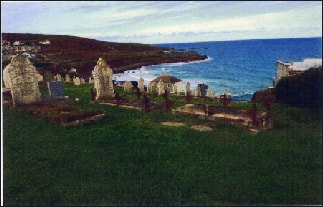
Maternal Great-great grandfather, father of Amelia Renowden Reese, my great-grandmother
The earliest members of the Renowden family came from Cornwall, the southwestern-most part of England, so at least half of the "Welsh" family heritage is actually English. Since Cornwall and Wales were both inhabited by descendants of the ancient Bretons (now called “Celtic”), the original modern settlers in the British Isles, it is safe to say they are all from the same or similar stock. Their native language, both Celtic dialogs, are similar.
John Renowden was born in a tiny sea coast town of St. Ives, Cornwall, in the southwest corner of England, in the year 1815.
The earliest members of the Renowden family came from Cornwall, the southwestern-most part of England, so at least half of the "Welsh" family heritage is actually English. Since Cornwall and Wales were both inhabited by descendants of the ancient Bretons (now called “Celtic”), the original modern settlers in the British Isles, it is safe to say they are all from the same or similar stock. Their native language, both Celtic dialogs, are similar.
John Renowden was born in a tiny sea coast town of St. Ives, Cornwall, in the southwest corner of England, in the year 1815.
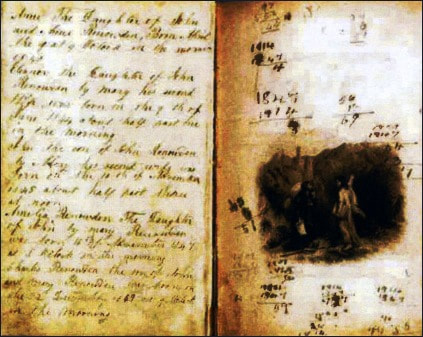
His parents were John Renowden of Zennor, Cornwall (1792-1835) and Bathsheba Allen (1785-1868)
As a young man, John migrated to Wales, to work in the Nantymwyn mine in Rhandirmwyn, county of Carmarthen, Wales. He most likely traveled by ship, probably in the late 1830's. Both Cornwall and central Wales were mining areas but the Cornish people had the reputation for more knowledge and experience and were highly sought after as employees when times were good. In 1836, the lease ownership of the mine was transferred to a Cornish family named Williams and it is probable that many Cornish miners migrated to Wales then.
Sometime between 1846 and 1851, John established a public house called the Royal Oak Inn. It had a few rooms to let upstairs, and downstairs the public house served food and drinks. The stone building was heated by two large fireplaces, one at each end of the main room. The Inn was in the Renowden family for over 100 years.
John Renowden married three times, each time to a local area woman. His first wife, Anne Davies, died in childbirth at the age of 21, bearing their third child. Only one child lived, Anne (born 1840), and she apparently was raised by another family after her mother’s death (in 1842).
His second wife (my great-great grandmother) was Mary Williams (1816-1882) from Llansawel, a small town about 12 miles from Rhandirmwyn. Her father was Charles Williams. John and Mary were married October 4, 1843, and had seven children, five boys and two girls. My great-grandmother, Amelia Renowden (1847-1884) was the third-born and the only surviving girl. John Renowden recorded all the children’s births in the front pages of a copy of Pilgrim’s Progress. I received this book after my trip to Wales in 2012, as the last surviving Renowden relative in the area had died without descendants.
As a young man, John migrated to Wales, to work in the Nantymwyn mine in Rhandirmwyn, county of Carmarthen, Wales. He most likely traveled by ship, probably in the late 1830's. Both Cornwall and central Wales were mining areas but the Cornish people had the reputation for more knowledge and experience and were highly sought after as employees when times were good. In 1836, the lease ownership of the mine was transferred to a Cornish family named Williams and it is probable that many Cornish miners migrated to Wales then.
Sometime between 1846 and 1851, John established a public house called the Royal Oak Inn. It had a few rooms to let upstairs, and downstairs the public house served food and drinks. The stone building was heated by two large fireplaces, one at each end of the main room. The Inn was in the Renowden family for over 100 years.
John Renowden married three times, each time to a local area woman. His first wife, Anne Davies, died in childbirth at the age of 21, bearing their third child. Only one child lived, Anne (born 1840), and she apparently was raised by another family after her mother’s death (in 1842).
His second wife (my great-great grandmother) was Mary Williams (1816-1882) from Llansawel, a small town about 12 miles from Rhandirmwyn. Her father was Charles Williams. John and Mary were married October 4, 1843, and had seven children, five boys and two girls. My great-grandmother, Amelia Renowden (1847-1884) was the third-born and the only surviving girl. John Renowden recorded all the children’s births in the front pages of a copy of Pilgrim’s Progress. I received this book after my trip to Wales in 2012, as the last surviving Renowden relative in the area had died without descendants.
THE ROYAL OAK INN, about 1890.
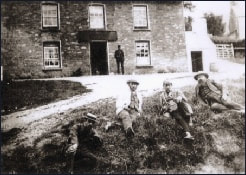
Left to right: David Vincent Lewis (Schoolmaster), Johnny Renowden (Owner of the Royal Oak Inn and eldest son of John Renowden, brother of Amelia), David Owen (Schoolmaster, Postmaster and historian of the Rhandirmwyn area), and David Thomas (neighbor on Pannau Street and owner of the Miner’s Arms pub).
Royal Oak Inn, 2008. Seina Johndro (Four times great-granddaughter of John Renowden who built the inn) and Pat Schumacher (Two times great-granddaughter)
AMELIA RENOWDEN 16 Nov 1847 - 1 Dec 1884
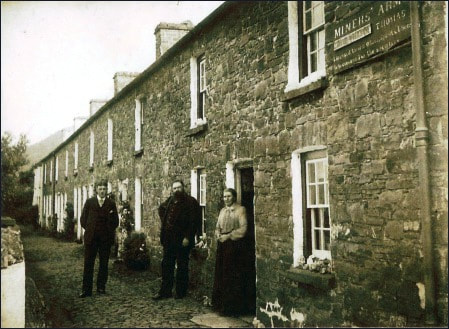 Miners Arms, Pannau Street
Miners Arms, Pannau Street
My Maternal Great-grandmother and mother of my grandfather, Rees Reese. daughter of John Renowden, founder of the Royal Oak Inn.
The short story of Amelia’s life, pieced together with census data, birth and death records and ship manifests, tells a story of a young woman who bore nine children and lost four of them within a two-year period. She died two years after immigrating to America, at age 37, most likely as a result of the birth of her ninth child, who also died.
Amelia was my great-grandmother and was born November 16, 1847, in Rhandirmwyn, Carmarthenshire County, Wales. She was the second of six children, and her parents, John and Mary Renowden, were owners of a new pub (the Royal Oak Inn built about 1846), located in the center of the mining village of Rhandirmwyn. She was the only surviving girl child. Most likely, Amelia had no schooling at all and, in her teen years, worked as a bar maid.
At age 22 she married James David Reese, the son of local farmers just south of town. They had six children in nine years, and lived in a tiny stone row house on Pannau Street, #4. Eight families lived in the row of attached two-room cottages. The housing was provided for the miners to rent, and many of the families had origins in Cornwall.
Winters in the low mountains around Rhandirmwyn could be quite cold, with a raw wind whipping up between the high hills. The house had two windows which had to be stuffed around the edges with paper or cloth in the winters and hung with curtains to keep out the cold. The only heat was from the fireplace. James worked in the nearby mine and was sometimes paid with lumps of coal. The family buried coal in the ground to store it until needed. (Christine Reilly, who bought the stone row house in 2008, found a large lump of coal buried in the garden).
Life in the years from Amelia’s birth in1847, to the time they left for America in 1882, was harsh and hungry. The family had no wealth to own a horse, so any transportation was on foot, or had to be purchased. In the backyard of the row house, families kept gardens and probably a coop of chickens, perhaps a goat for milk. The garden was essential to provide food; there were no grocery stores
Below, Pannau Street about 1890 showing the Thomas family, neighbors of James and Amelia Reese. The Thomas’s ran the Miners’ Arms, a pub, from their two-room home. It was located on the end of the row, next to the path the miners used when they walked home at the end of the day. You can see the sign next to the upstairs window.
James and Amelia lived in Unit #4, in the center of the row. The downstairs was one great room, with a fireplace for cooking and providing warmth to the entire home. All family activities, except sleeping, occurred in this room. Upstairs was one bedroom, where six children and two adults slept. There was probably only one bed. The rooms were small, perhaps 9 by 10 feet. There was no running water and the toilet was outside.
Children were born at home, perhaps with a local woman attending. Amelia gave birth to David in 1871 (she was 24), John in 1872, Rees (my grandfather) in 1874, Daniel in 1875, Mary in 1876, Isaac in 1879, and Elizabeth in 1880.
Amelia had two more babies in America, Bessie, born in 1883, and Charles, still born, in 1984. Also in 1883, a diphtheria epidemic took her second son, John, and baby Isaac.
I can find no record of Amelia after 1884. My assumption is that she died in childbirth, along with Charles. Before she died, Amelia lost four of her nine children. She was 37 years old.
The short story of Amelia’s life, pieced together with census data, birth and death records and ship manifests, tells a story of a young woman who bore nine children and lost four of them within a two-year period. She died two years after immigrating to America, at age 37, most likely as a result of the birth of her ninth child, who also died.
Amelia was my great-grandmother and was born November 16, 1847, in Rhandirmwyn, Carmarthenshire County, Wales. She was the second of six children, and her parents, John and Mary Renowden, were owners of a new pub (the Royal Oak Inn built about 1846), located in the center of the mining village of Rhandirmwyn. She was the only surviving girl child. Most likely, Amelia had no schooling at all and, in her teen years, worked as a bar maid.
At age 22 she married James David Reese, the son of local farmers just south of town. They had six children in nine years, and lived in a tiny stone row house on Pannau Street, #4. Eight families lived in the row of attached two-room cottages. The housing was provided for the miners to rent, and many of the families had origins in Cornwall.
Winters in the low mountains around Rhandirmwyn could be quite cold, with a raw wind whipping up between the high hills. The house had two windows which had to be stuffed around the edges with paper or cloth in the winters and hung with curtains to keep out the cold. The only heat was from the fireplace. James worked in the nearby mine and was sometimes paid with lumps of coal. The family buried coal in the ground to store it until needed. (Christine Reilly, who bought the stone row house in 2008, found a large lump of coal buried in the garden).
Life in the years from Amelia’s birth in1847, to the time they left for America in 1882, was harsh and hungry. The family had no wealth to own a horse, so any transportation was on foot, or had to be purchased. In the backyard of the row house, families kept gardens and probably a coop of chickens, perhaps a goat for milk. The garden was essential to provide food; there were no grocery stores
Below, Pannau Street about 1890 showing the Thomas family, neighbors of James and Amelia Reese. The Thomas’s ran the Miners’ Arms, a pub, from their two-room home. It was located on the end of the row, next to the path the miners used when they walked home at the end of the day. You can see the sign next to the upstairs window.
James and Amelia lived in Unit #4, in the center of the row. The downstairs was one great room, with a fireplace for cooking and providing warmth to the entire home. All family activities, except sleeping, occurred in this room. Upstairs was one bedroom, where six children and two adults slept. There was probably only one bed. The rooms were small, perhaps 9 by 10 feet. There was no running water and the toilet was outside.
Children were born at home, perhaps with a local woman attending. Amelia gave birth to David in 1871 (she was 24), John in 1872, Rees (my grandfather) in 1874, Daniel in 1875, Mary in 1876, Isaac in 1879, and Elizabeth in 1880.
Amelia had two more babies in America, Bessie, born in 1883, and Charles, still born, in 1984. Also in 1883, a diphtheria epidemic took her second son, John, and baby Isaac.
I can find no record of Amelia after 1884. My assumption is that she died in childbirth, along with Charles. Before she died, Amelia lost four of her nine children. She was 37 years old.
Now on to Amelia’s husband, James David Reese and his story……
DAVID REES & ELIZABETH COWLING
(1812 - 1879) (1810 - 1877)
Maternal Great-great grandparents, father of James David Reese
David Rees was born in the village of Rhandirmwyn, in a house named Pencarreg, along the main road, just up from the Royal Oak Inn. His parents were John and Isabel Rees.
Elizabeth Cowling Rees’ family was from Cornwall. Her father, Thomas Cowling, was born in St. Agnes, Cornwall, England in 1768. The Cornish were known for their mining skills and were recruited to work in the Carmarthenshire mines when times were good. He brought along his wife, Anna James (1762-1853). Anna was later called Hannah. Elizabeth was their only child, born on Crincae farm, when Hannah was nearly 50 years old. Hannah James Cowling lived with Elizabeth, her only child, all her life, and lived to be 91 years old, an astonishing age for that era.
David and Elizabeth were married November 29,1839, and they farmed her parents’ farm (Crincae) the rest of their lives. David worked in the Nantymwyn Mine as well as farming his in-laws’ farm, and lived to the age of 67. He and Elizabeth had nine chidren, James (my great-grandfather) was the 4th. Children died frequently, from accidents and contagious illnesses; they lost several of their children. One particularly sad episode involved William (two years younger than James) who took a horse and cart to a neighboring town to obtain lime to fertilize the farm fields. On the way home, the full cart overturned, pinning William underneath. He died of the injuries--he was fourteen years old.
It is said the Elizabeth never got over the deaths of her children and as reported in the local paper, “It is common knowledge that depression caused the termination of her life”. She was 66 years old.
I am attaching a report written by current local resident, Handel Jones, who found this information while searching for his own family (unrelated). It was kindly passed on to me by Alun Jones, his friend, who assisted my brother and I greatly on our trip to Wales in 2012. From this, one can obtain an understanding of the sadness of the times, and the difficulties of life in the mid to late 1800’s in Wales.
David Rees was born in the village of Rhandirmwyn, in a house named Pencarreg, along the main road, just up from the Royal Oak Inn. His parents were John and Isabel Rees.
Elizabeth Cowling Rees’ family was from Cornwall. Her father, Thomas Cowling, was born in St. Agnes, Cornwall, England in 1768. The Cornish were known for their mining skills and were recruited to work in the Carmarthenshire mines when times were good. He brought along his wife, Anna James (1762-1853). Anna was later called Hannah. Elizabeth was their only child, born on Crincae farm, when Hannah was nearly 50 years old. Hannah James Cowling lived with Elizabeth, her only child, all her life, and lived to be 91 years old, an astonishing age for that era.
David and Elizabeth were married November 29,1839, and they farmed her parents’ farm (Crincae) the rest of their lives. David worked in the Nantymwyn Mine as well as farming his in-laws’ farm, and lived to the age of 67. He and Elizabeth had nine chidren, James (my great-grandfather) was the 4th. Children died frequently, from accidents and contagious illnesses; they lost several of their children. One particularly sad episode involved William (two years younger than James) who took a horse and cart to a neighboring town to obtain lime to fertilize the farm fields. On the way home, the full cart overturned, pinning William underneath. He died of the injuries--he was fourteen years old.
It is said the Elizabeth never got over the deaths of her children and as reported in the local paper, “It is common knowledge that depression caused the termination of her life”. She was 66 years old.
I am attaching a report written by current local resident, Handel Jones, who found this information while searching for his own family (unrelated). It was kindly passed on to me by Alun Jones, his friend, who assisted my brother and I greatly on our trip to Wales in 2012. From this, one can obtain an understanding of the sadness of the times, and the difficulties of life in the mid to late 1800’s in Wales.
JAMES DAVID REESE 2 Aug 1845 - 8 Oct 1918
Maternal Great-grandfather and husband of Amelia Renowden
James David Reese was born on a farm named Crincae, just outside of Rhandirmwyn, Wales on 2 August 1845. He was the fourth of nine children.
I could learn little about his early life except that he was raised on a farm and went to work very early in the lead mine that ran for miles and miles underneath the village of Rhandirmwyn. His mother’s families were miners and his father worked in both the mine and at farming.
Mining was the main source of income for the village. James worked in the nearby lead mine which provided employment for up to 400 people in the best years. But the mine prosperity fluctuated and there were bad years when many were laid off. When the mine needed more men, they hired experienced miners from Cornwall, England, who were also of Celtic heritage. The Cornish moved to Rhandirmwyn, settled in, and many intermarried with local women, including both Amelia and James’ parents.
James grandparents were from Cornwall, and his mother was Cornish. Amelia’s father was born in Cornwall but her mother, Mary, was from a local family. When the mine had a downturn, prejudice against the “outsiders” (the Cornish) grew. All Cornish men were told to leave, but John Renowden was allowed to remain because he had married a local girl and owned a local business, the pub, that was important to the community. James’ parents also remained more easily, most likely because his mother did not displace a mining job.
The Nantymwyn mine was underground, and work was unbearably difficult and dangerous. There were many tragic accidents and many miners died at a young age of lung disease and lead toxicity . James toiled underneath the ground most days and when work was slack, was probably laid off. The town sat on top of an underground lead mine which, it is told, was first mined by the Romans in the 4th century. The mine runs for miles under the mountainous community and provided a livelihood to most of the area residents for centuries.
The toxic aspect of lead was not known, but in 1974 when I visited Rhandirmwyn, I asked the oldest person I could find in town, a lovely lady named Miss Harris, in her 80’s, to describe the oldest people she could remember from her childhood. She responded that there were no old people in town when she was young; they all died at a young age of lead poisoning. The hard and uncertain conditions of working as a miner most likely prompted their move to America in 1882 .
Two years after James’ mother died, the family prepared to leave for America.
James left first, to look for work and find a place for his family to live. A few years later, in 1882, Amelia and six children (David, John, Rees, Daniel, Mary and Isaac) along with her sister-in-law and three more children, boarded the Ship Wyoming in Liverpool and sailed to America.
The night before sailing, in a Liverpool boarding house, two-year old Elizabeth, the seventh child of Amelia and James, climbed the stairs to bed with a candle stick in her hand. Her night gown caught fire and she burned to death. The family left the next day for America, with passage already booked and nothing to be done.
Amelia had two more babies in America, Bessie, born in 1883, and Charles, still born, in 1984, and the probable cause of her death. Also in 1883, a diphtheria epidemic took her second son, John, and baby Isaac.
James lived a long time after Amelia died and never married again. He worked in Pennsylvania as a miner, a laborer, and sometimes as a nurse or orderly in a hospital. His eldest son, David, returned to Wales when he was 21 and lived there about 10 years, married a Welsh girl named Catherine, and had two children there. He returned to America in 1899. James lives in Wilkes-Barre until his children were grown and then lived for awhile with Reese and his family, in Minnesota. He returned to Pennsylvania and died in 1918, at the age of 73
I could learn little about his early life except that he was raised on a farm and went to work very early in the lead mine that ran for miles and miles underneath the village of Rhandirmwyn. His mother’s families were miners and his father worked in both the mine and at farming.
Mining was the main source of income for the village. James worked in the nearby lead mine which provided employment for up to 400 people in the best years. But the mine prosperity fluctuated and there were bad years when many were laid off. When the mine needed more men, they hired experienced miners from Cornwall, England, who were also of Celtic heritage. The Cornish moved to Rhandirmwyn, settled in, and many intermarried with local women, including both Amelia and James’ parents.
James grandparents were from Cornwall, and his mother was Cornish. Amelia’s father was born in Cornwall but her mother, Mary, was from a local family. When the mine had a downturn, prejudice against the “outsiders” (the Cornish) grew. All Cornish men were told to leave, but John Renowden was allowed to remain because he had married a local girl and owned a local business, the pub, that was important to the community. James’ parents also remained more easily, most likely because his mother did not displace a mining job.
The Nantymwyn mine was underground, and work was unbearably difficult and dangerous. There were many tragic accidents and many miners died at a young age of lung disease and lead toxicity . James toiled underneath the ground most days and when work was slack, was probably laid off. The town sat on top of an underground lead mine which, it is told, was first mined by the Romans in the 4th century. The mine runs for miles under the mountainous community and provided a livelihood to most of the area residents for centuries.
The toxic aspect of lead was not known, but in 1974 when I visited Rhandirmwyn, I asked the oldest person I could find in town, a lovely lady named Miss Harris, in her 80’s, to describe the oldest people she could remember from her childhood. She responded that there were no old people in town when she was young; they all died at a young age of lead poisoning. The hard and uncertain conditions of working as a miner most likely prompted their move to America in 1882 .
Two years after James’ mother died, the family prepared to leave for America.
James left first, to look for work and find a place for his family to live. A few years later, in 1882, Amelia and six children (David, John, Rees, Daniel, Mary and Isaac) along with her sister-in-law and three more children, boarded the Ship Wyoming in Liverpool and sailed to America.
The night before sailing, in a Liverpool boarding house, two-year old Elizabeth, the seventh child of Amelia and James, climbed the stairs to bed with a candle stick in her hand. Her night gown caught fire and she burned to death. The family left the next day for America, with passage already booked and nothing to be done.
Amelia had two more babies in America, Bessie, born in 1883, and Charles, still born, in 1984, and the probable cause of her death. Also in 1883, a diphtheria epidemic took her second son, John, and baby Isaac.
James lived a long time after Amelia died and never married again. He worked in Pennsylvania as a miner, a laborer, and sometimes as a nurse or orderly in a hospital. His eldest son, David, returned to Wales when he was 21 and lived there about 10 years, married a Welsh girl named Catherine, and had two children there. He returned to America in 1899. James lives in Wilkes-Barre until his children were grown and then lived for awhile with Reese and his family, in Minnesota. He returned to Pennsylvania and died in 1918, at the age of 73
REES DAVID REESE
30 May 1874 - 22 September 1955
Maternal Grandfather
Rees Reese was born to Amelia Renowden Rees and James David Rees in the village of Rhandirmwyn, County of Carmarthenshire, Wales, in 1874. He was the third child, and the third son, born to the family. He eventually had eight siblings, although four died in childhood. The four remaining were David (born 1871), Daniel (born 1875), Mary (born 1876) and Bessie (born 1883 in America).
The family lived at #4, Pannau Street, a stone row house of eight homes, built especially for the miner’s families. The house had two rooms, one downstairs and one upstairs and was heated in the winter by a fireplace in the living room, using coal. The entire family (nine people at its most) slept together in the single upstairs bedroom.
I don’t know if Rees attended school in Wales although a school had been formed in the village by that time. None of his family appears in the school rosters. I do know that he had eloquent handwriting and could read newspapers at the end of his life.
The family moved to America in 1882, when Rees was eight years old. At that time, the family consisted of seven children, Rees being right in the middle by age. Tragically, the youngest child, Elizabeth who was two years old, burned to death when her nightgown caught fire from a candle, the night before the family sailed from Liverpool.
In America, the family settled in Wilkes-Barre, Pennsylvania, where mining skills were useful and jobs could be found. Within a year, a diphtheria epidemic took two more children: John, age eleven and the next oldest boy to Rees, and Isaac, now four years old, died in 1883. Also in 1883, a new baby girl, Bessie, joined the family, and in 1884 another baby was on the way. Amelia and the baby, Charles, both died in 1884, most likely a result of a difficult childbirth.
At age ten, Rees was left without a mother and grieving the loss of three siblings. In addition, there was a one-year-old baby sister with no mother. It’s not hard to imagine how difficult those years were for this immigrant family.
The oldest child, David, was 13, but by the time he was 18, he had returned to Wales for about ten years where he married and had children. There is a story that James, his father, also returned to Wales about that time but I can’t corroborate it. If so, he returned within a year as he is “missing” from directories during the year 1890. If true, that would mean Rees was the lone head of the family at age 15 or 16 for about a year, with a seven-year old sister, and responsibility for two other siblings.
The family lived at #4, Pannau Street, a stone row house of eight homes, built especially for the miner’s families. The house had two rooms, one downstairs and one upstairs and was heated in the winter by a fireplace in the living room, using coal. The entire family (nine people at its most) slept together in the single upstairs bedroom.
I don’t know if Rees attended school in Wales although a school had been formed in the village by that time. None of his family appears in the school rosters. I do know that he had eloquent handwriting and could read newspapers at the end of his life.
The family moved to America in 1882, when Rees was eight years old. At that time, the family consisted of seven children, Rees being right in the middle by age. Tragically, the youngest child, Elizabeth who was two years old, burned to death when her nightgown caught fire from a candle, the night before the family sailed from Liverpool.
In America, the family settled in Wilkes-Barre, Pennsylvania, where mining skills were useful and jobs could be found. Within a year, a diphtheria epidemic took two more children: John, age eleven and the next oldest boy to Rees, and Isaac, now four years old, died in 1883. Also in 1883, a new baby girl, Bessie, joined the family, and in 1884 another baby was on the way. Amelia and the baby, Charles, both died in 1884, most likely a result of a difficult childbirth.
At age ten, Rees was left without a mother and grieving the loss of three siblings. In addition, there was a one-year-old baby sister with no mother. It’s not hard to imagine how difficult those years were for this immigrant family.
The oldest child, David, was 13, but by the time he was 18, he had returned to Wales for about ten years where he married and had children. There is a story that James, his father, also returned to Wales about that time but I can’t corroborate it. If so, he returned within a year as he is “missing” from directories during the year 1890. If true, that would mean Rees was the lone head of the family at age 15 or 16 for about a year, with a seven-year old sister, and responsibility for two other siblings.
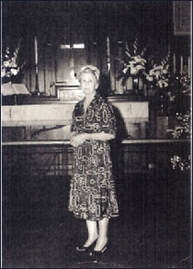
In my grandfather’s eyes, the true hero of the orphaned family was Mary, or “May” as my grandfather lovingly called her. May took over the nurturing of the family after her mother died. She was eight years old when Amelia died and baby Bessie was only one year old. May, being the only other girl, was most probably her “mother” from then on. She never worked outside the home, but always kept house for her father and brothers. Later when Daniel married, his wife died and he was left with three small children. May moved to Detroit and helped him raise those children, too. She never married and never had her own family
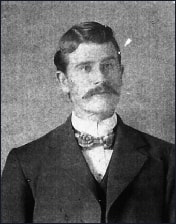
Rees started working by age 18, first as a driver, then a miner for the next 4-6 years, and at age 24, he began working as a surveyor. His father worked all his life as a laborer or a miner, but Rees managed to become a white-collar worker eventually, and left the work as miner behind him.
On June 18, 1902, Rees married Catherine Kemery Moyer in West Pittston, Pennsylvania. I don’t know how they met and what their courtship was like, but all the pictures of Grandpa during those years are smiling with twinkling eyes. I have a small picture of him with handwritten notes on the back: “Nov 12, 1899; July 18, 1900 Pic; Aug 5, 1900 Yes; Feb. 2 1902 Ring”….and on June 18, 1902, they were married. I believe it is a “diary” of the courtship progress.
Soon after the wedding, the couple left for Minnesota to join Catherine’s older brother Will there. They settled in Hibbing and later Virginia, and by 1904, had their first child, William Moyer Reese. Howard David Reese came along in 1907, and in 1912, Catherine Rebecca Reese (my mother) was born.
On June 18, 1902, Rees married Catherine Kemery Moyer in West Pittston, Pennsylvania. I don’t know how they met and what their courtship was like, but all the pictures of Grandpa during those years are smiling with twinkling eyes. I have a small picture of him with handwritten notes on the back: “Nov 12, 1899; July 18, 1900 Pic; Aug 5, 1900 Yes; Feb. 2 1902 Ring”….and on June 18, 1902, they were married. I believe it is a “diary” of the courtship progress.
Soon after the wedding, the couple left for Minnesota to join Catherine’s older brother Will there. They settled in Hibbing and later Virginia, and by 1904, had their first child, William Moyer Reese. Howard David Reese came along in 1907, and in 1912, Catherine Rebecca Reese (my mother) was born.
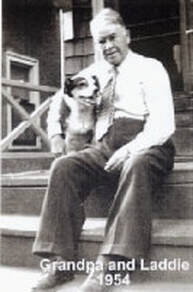
After Grandma Reese died, in 1943, Grandpa lived alone and worked as a civil engineer for the City of Virginia. He traveled to San Diego, to Mexico, and to Florida. He never went back to Wales.
About 1949 to 1954, Grandpa Reese lived with us after he suffered a heart attack. He helped take care of me on school days while my mom was working. His specialty for lunch was fried potatoes. I think it might have been his only culinary skill. In our small three bedroom house, Mom and I shared a bedroom, and Bob and Grandpa each had a room. It was a pretty crowded place.
Grandpa loved to tell stories and after school, I heard things that he had never told anyone else. He told me about the death of his tiny sister, Elizabeth, on the night before they sailed from England to America. She was two, and carried a candle up the stairs of a boarding house in Liverpool, where they spent the last night before sailing. Her nightgown caught fire and she burned to death. The family had to leave the next day on the ship where they had booked passage. It was a sad family secret that he had never told anyone else before, but he, at age 8, had strong memories of it.
Grandpa had a great sense of humor and liked to tease and chuckle about things. He always wore a suit with a vest, and dress shirt, the same clothes he had worn to work as a mine clerk and city employee. He surpassed his family roots and did not have to work as a miner down in the pit, but in an office. He loved Laddie, our old dog. The two old friends sat together many hours on the front steps of the house.
As his health got worse, he went to the Masonic Home in Richfield, Minnesota, to live the last years of his life. In 1954, Bob went off to college in Colorado and Grandpa moved to Minneapolis and the house had only two of us, Mom and me. Grandpa died in 1955, after suffering a stroke. Laddie died the same year.
About 1949 to 1954, Grandpa Reese lived with us after he suffered a heart attack. He helped take care of me on school days while my mom was working. His specialty for lunch was fried potatoes. I think it might have been his only culinary skill. In our small three bedroom house, Mom and I shared a bedroom, and Bob and Grandpa each had a room. It was a pretty crowded place.
Grandpa loved to tell stories and after school, I heard things that he had never told anyone else. He told me about the death of his tiny sister, Elizabeth, on the night before they sailed from England to America. She was two, and carried a candle up the stairs of a boarding house in Liverpool, where they spent the last night before sailing. Her nightgown caught fire and she burned to death. The family had to leave the next day on the ship where they had booked passage. It was a sad family secret that he had never told anyone else before, but he, at age 8, had strong memories of it.
Grandpa had a great sense of humor and liked to tease and chuckle about things. He always wore a suit with a vest, and dress shirt, the same clothes he had worn to work as a mine clerk and city employee. He surpassed his family roots and did not have to work as a miner down in the pit, but in an office. He loved Laddie, our old dog. The two old friends sat together many hours on the front steps of the house.
As his health got worse, he went to the Masonic Home in Richfield, Minnesota, to live the last years of his life. In 1954, Bob went off to college in Colorado and Grandpa moved to Minneapolis and the house had only two of us, Mom and me. Grandpa died in 1955, after suffering a stroke. Laddie died the same year.
Schumacher / Johnson / Reese Family Tree
Johnson / Reese Family Tree
John T Williams
John T Williams
Ganed John T Williams ar Fferm Cwmsaethau, Rhandir-mwyn yn 1839, yn fab i Barbara a Thomas Williams. Ymadawodd â’r ysgol leol yn 16 oed i fynd i weithio yng ngwaith plwm Nant-y-mwyn, ond yn 1859 pan oedd yn 20 oed, aeth John T. i America, gan hwylio o Abertawe a chyrraedd Efrog Newydd fis yn ddiweddarach. Ymgartrefodd yn Scranton, Pennsylvania, lle bu’n gweithio yng Nglofa Hampton i’r Delaware, Lockwana and Eastern Railroad Company. Ymhen fawr o dro, fodd bynnag, roedd John T. ar grwydr unwaith eto, a’r tro hon aeth i chwilio am aur yng Nghaliffornia. Yn 1861 hwyliodd ar fwrdd llong ager o Efrog Newydd i San Francisco. Bu yng Nghaliffornia am bum mlynedd, gan gloddio yn San Juan. Er na chafodd ei freuddwyd o ddod yn ddyn cyfoethog ei gwireddu, roedd John T. yn llawn penderfyniad. Dychwelodd i Scranton ac yn 1867 a phriodi â Mary Lewis o Neath, Pennsylvania. Roedd ei theulu hi’n hanu o Drecynon, ger Aberdâr yng Nghymru. Ymgartrefodd y ddau yn Hampton Street, Scranton, a chawsant bump o blant. Aeth John T. yn ôl i weithio yn y pyllau glo a daeth yn fforman. Fodd bynnag, dechreuodd fuddsoddi mewn cloddio a chafodd ei ddisgrifio mewn un cyfrifiad fel landlord a chyfalafwr. Yn 1874 roedd yn un o’r cyfranddalwyr gwreiddiol pan sefydlwyd y West Side Bank.
Yn 1884, ar ôl marwolaeth ei dad, bu John T. yn ymweld â'i fam yn Rhandir-mwyn. Yn fuan wedyn, cafodd ei enwebu gan y Blaid Weriniaethol fel ymgeisydd i fod yn ddeddfwr talaith Pennsylvania a chafodd ei ethol â mwyafrif o1300. Roedd hon yn swydd gyfrifol iawn. Mewn gwirionedd, roedd yn aelod o’r llywodraeth ar gyfer Talaith Pennsylvania gyda chyfrifoldeb dros weithredu deddfau’r dalaith.
Yn 1886 sefydlodd fusnes masnachol cyffredinol dan yr enw Williams and Co. Roedd mewn partneriaeth â John Williams arall, sef John H. Williams – ac roedd gwreiddiau hwnnw hefyd yn Rhandir-mwyn. Bu’n fenter lwyddiannus dros ben. Roedd John T. yn gyfarwyddwr y Scranton Packing Company yn ogystal, ac roedd wedi buddsoddi’n sylweddol yn y diwydiant glo. Roedd yn gyfarwyddwr a thrysorydd y Cambrian Mutual Fire Insurance Company.
Yn 1896 roedd John T. yn un o'r cynrychiolwyr yng Nghyngres Genedlaethol y Gweriniaethwyr yn St Louis lle cafodd William McKinley ei enwebu am y tro cyntaf yn ymgeisydd gweriniaethol ar gyfer Arlywyddiaeth yr Unol Daleithiau. Fe’i etholwyd yn 1897 a bu yn y swydd tan 1901.
Daeth John T. yn llywydd y West Side Bank a bu farw yn 1903.
(Rydym yn ddiolchgar i Martha Phillips, Scranton, wyres John T. Williams am yr wybodaeth hon).
Ganed John T Williams ar Fferm Cwmsaethau, Rhandir-mwyn yn 1839, yn fab i Barbara a Thomas Williams. Ymadawodd â’r ysgol leol yn 16 oed i fynd i weithio yng ngwaith plwm Nant-y-mwyn, ond yn 1859 pan oedd yn 20 oed, aeth John T. i America, gan hwylio o Abertawe a chyrraedd Efrog Newydd fis yn ddiweddarach. Ymgartrefodd yn Scranton, Pennsylvania, lle bu’n gweithio yng Nglofa Hampton i’r Delaware, Lockwana and Eastern Railroad Company. Ymhen fawr o dro, fodd bynnag, roedd John T. ar grwydr unwaith eto, a’r tro hon aeth i chwilio am aur yng Nghaliffornia. Yn 1861 hwyliodd ar fwrdd llong ager o Efrog Newydd i San Francisco. Bu yng Nghaliffornia am bum mlynedd, gan gloddio yn San Juan. Er na chafodd ei freuddwyd o ddod yn ddyn cyfoethog ei gwireddu, roedd John T. yn llawn penderfyniad. Dychwelodd i Scranton ac yn 1867 a phriodi â Mary Lewis o Neath, Pennsylvania. Roedd ei theulu hi’n hanu o Drecynon, ger Aberdâr yng Nghymru. Ymgartrefodd y ddau yn Hampton Street, Scranton, a chawsant bump o blant. Aeth John T. yn ôl i weithio yn y pyllau glo a daeth yn fforman. Fodd bynnag, dechreuodd fuddsoddi mewn cloddio a chafodd ei ddisgrifio mewn un cyfrifiad fel landlord a chyfalafwr. Yn 1874 roedd yn un o’r cyfranddalwyr gwreiddiol pan sefydlwyd y West Side Bank.
Yn 1884, ar ôl marwolaeth ei dad, bu John T. yn ymweld â'i fam yn Rhandir-mwyn. Yn fuan wedyn, cafodd ei enwebu gan y Blaid Weriniaethol fel ymgeisydd i fod yn ddeddfwr talaith Pennsylvania a chafodd ei ethol â mwyafrif o1300. Roedd hon yn swydd gyfrifol iawn. Mewn gwirionedd, roedd yn aelod o’r llywodraeth ar gyfer Talaith Pennsylvania gyda chyfrifoldeb dros weithredu deddfau’r dalaith.
Yn 1886 sefydlodd fusnes masnachol cyffredinol dan yr enw Williams and Co. Roedd mewn partneriaeth â John Williams arall, sef John H. Williams – ac roedd gwreiddiau hwnnw hefyd yn Rhandir-mwyn. Bu’n fenter lwyddiannus dros ben. Roedd John T. yn gyfarwyddwr y Scranton Packing Company yn ogystal, ac roedd wedi buddsoddi’n sylweddol yn y diwydiant glo. Roedd yn gyfarwyddwr a thrysorydd y Cambrian Mutual Fire Insurance Company.
Yn 1896 roedd John T. yn un o'r cynrychiolwyr yng Nghyngres Genedlaethol y Gweriniaethwyr yn St Louis lle cafodd William McKinley ei enwebu am y tro cyntaf yn ymgeisydd gweriniaethol ar gyfer Arlywyddiaeth yr Unol Daleithiau. Fe’i etholwyd yn 1897 a bu yn y swydd tan 1901.
Daeth John T. yn llywydd y West Side Bank a bu farw yn 1903.
(Rydym yn ddiolchgar i Martha Phillips, Scranton, wyres John T. Williams am yr wybodaeth hon).
William R Lewis and Jane ‘Jenny’ Lewis
William R Lewis a Jane ‘Jenny’ Lewis
Hanesion Jane ‘Jenny” Lewis a’r Barnwr William Lewis, Troed-rhiw-fer, Rhandir-mwyn
Ymchwiliwyd gan W. J. Richards (Florida, UDA) un o ddisgynyddion y teulu Lewis.
Dyma hanes disgynyddion Joseph ac Ann Lewis (Vipond cyn priodi), Troed-rhiw-fer, Rhandir-mwyn. Nid oes unrhyw fanylion pellach am Joseph Lewis.
Credir bod Ann Vipond wedi’i geni yn 1804. Efallai ei bod yn chwaer i William Vipond y mae hanes helaeth am ei fywyd yn America. Mae rhagor o wybodaeth am y teulu Vipond ar y wefan www.vieuxpont.co.uk .
Roedd gan Joseph ac Ann Lewis ddau o blant:
Thomas Lewis, a aned yn 1830.
Rhys ‘Rees’ Joseph Lewis, a aned ym mis Chwefror 1832 yn Rhandir-mwyn.
Ar 16 Tachwedd 1853, yng Nghil-y-cwm, priodwyd Rhys Joseph Lewis ac Anne Jones. Fe’i ganed hi yn 1832 ym mhlwyf Cil-y-cwm.
Ganed y plant a ganlyn iddynt:
i. Joseph R. Lewis (1854)
ii. Mary Lewis (1856).
iii. Ann "Annie" Lewis (30 Tachwedd 1858)
iv. Jane "Jennie" Lewis (1862).
v. Catherine "Kate" Lewis (3 Hydref 1864).
vi. William R Lewis (26 Chwefror 1867).
Ymfudodd y teulu i America ac ymgartrefu yn nhalaith Pennsylvania.
Roedd Rhys Joseph Lewis, a fu’n gweithio yng ngwaith plwm Nant-y-mwyn, Rhandir-mwyn, wedi ymfudo i ardal Scranton er mwyn tyllu siafftiau.
Yn 1869, yn fuan ar ôl cyrraedd America, bu farw ei wraig Anne. Roedd hi’n 37 oed. Wnaeth e ddim ailbriodi a magwyd y plant ifainc gan ei ferch hynaf, Mary. Bu farw Rhys ar 15 Mehefin 1887 yn Scranton, Pennsylvania.
Priododd yr holl blant a chodi teuluoedd, ac mae eu disgynyddion yn byw yn America. Dyma hanes dau o’r plant, sef Jane ‘Jennie’ Lewis a William R. Lewis, a ddaeth yn ddinasyddion adnabyddus a pharchus yn Pennsylvania.
Roedd Jane yn weithgar iawn yn Urdd Seren y Dwyrain a Phlaid y Gweriniaethwyr. (Urdd Seren y Dwyrain yw'r sefydliad brawdgarol mwyaf yn y byd, ac mae hawl gan ddynion a menywod i fod yn aelodau ohono)
Mae'n bosibl taw Jane oedd y fenyw gyntaf i fod yn gynrychiolydd yng Nghynhadledd y Gweriniaethwyr. Roedd yn wraig fusnes nodedig. Hi sefydlodd Lewis & Reilly, Inc. yn Scranton. Roedd hwn yn fusnes gwerthu esgidiau pwysig a ddechreuodd fasnachu ar 15 Rhagfyr 1888. Priododd ag Elias Evans yn hwyr yn ei bywyd, ac nid oedd ganddi unrhyw blant. Bu farw ar 17 Rhagfyr 1940 yn Scranton. Mae’r busnes yn dal mewn bodolaeth ac mae’r enw Lewis & Reilly yn bodoli hyd heddiw.
Ar 20 Mehefin 1894, priododd William R. Lewis â Josephine Lloyd, a aned yn Scranton ar 7 Medi 1869. Roedd hi’n ferch i Joseph D. Lloyd a’i wraig Hannah (Jones cyn priodi). Graddiodd William o’r Ysgol Normal Daleithiol (Coleg Athrawon Taleithiol Bloomsburg erbyn hyn) yn 1886 a chwblhaodd y cwrs dwy flynedd mewn tri thymor am nad oedd ganddo ddigon o arian i dalu am y cyfnod llawn. Bu’n Brif Glerc y Llys o dan Thomas H. Dale. Bu’n clercio yn swyddfeydd y gyfraith i’r Barnwr Gunter, y Barnwr Alfred Hand, a William J. Hand hyd nes iddo gael ei alw i’r bar yn 1893. Bu’n Dwrnai Sirol Lackawanna o 1901-1906.
Am sawl blwyddyn, bu’n bartner gyda Herbert Taylor yng nghwmni Taylor & Lewis. Ceisiodd yn aflwyddiannus i fod yn farnwr, ond fe’i penodwyd i lenwi gweddill tymor y Barnwr Maxey gan y Llywodraethwr John Fisher ar 9 Rhagfyr 1930. Llwyddodd i gael ei ethol i ail dymor yn Farnwr yn y Llys Pleon Cyffredin yn 1932 (llofnodwyd ei gomisiwn gan y Llywodraethwr Gifford Pinchot) a bu farw o drawiad ar y galon, ar 17 Medi 1867, yn fuan ar ôl ymddeol o’r swydd. Gwelir portread ohono yn Ystafell Rhif 1 yn Llys Sirol Lackawanna yn Scranton.
Roedd yn gyfreithiwr a dyn busnes llwyddiannus iawn. Roedd yn berchen ar lofeydd yn Illinois ac, ar y cyd â’i chwaer Jane, roedd yn berchen ar fusnes Lewis & Reilly, Inc. Roedd iddo enw da am onestrwydd fel cyfreithiwr a barnwr. Fe’i ganed yng Nghymru, ond daeth i America pan oedd yn faban. Gallai siarad Cymraeg, roedd yn weithgar mewn cylchoedd Cymraeg ac roedd yn perthyn i’r Seiri Rhyddion. Byddai’n mynychu gwasanaethau crefyddol yn gyson hyd nes i’w blant gael eu geni, sef Hanna (1896) a Mary Lloyd Lewis (1898).
Wedyn, byddai’n treulio’r Sul yn gweithio o gwmpas y cartref ac yn cyflawni ei ddyletswyddau fel rhiant. Arferai gerdded i lawr y stryd â’i ddwylo y tu ôl i’w gefn. Nid oedd yn gyrru car, a byddai ‘Shink’ Davis, neu ei ferch Gertrude yn ei yrru o le i le.
Rydym, yn ddiolchgar iawn i Bill am roi’r wybodaeth am y teulu Lewis. Mae yna lawer mwy, na chafodd ei gynnwys eto ar y wefan. Rydym wrthi’n creu coeden deulu ar gyfer y teulu. Os ydych chi’n ymchwilio i hanes y teulu Lewis o Randir-mwyn ac am wybod mwy amdano, byddwch cystal â chysylltu â’r wefan.
Hanesion Jane ‘Jenny” Lewis a’r Barnwr William Lewis, Troed-rhiw-fer, Rhandir-mwyn
Ymchwiliwyd gan W. J. Richards (Florida, UDA) un o ddisgynyddion y teulu Lewis.
Dyma hanes disgynyddion Joseph ac Ann Lewis (Vipond cyn priodi), Troed-rhiw-fer, Rhandir-mwyn. Nid oes unrhyw fanylion pellach am Joseph Lewis.
Credir bod Ann Vipond wedi’i geni yn 1804. Efallai ei bod yn chwaer i William Vipond y mae hanes helaeth am ei fywyd yn America. Mae rhagor o wybodaeth am y teulu Vipond ar y wefan www.vieuxpont.co.uk .
Roedd gan Joseph ac Ann Lewis ddau o blant:
Thomas Lewis, a aned yn 1830.
Rhys ‘Rees’ Joseph Lewis, a aned ym mis Chwefror 1832 yn Rhandir-mwyn.
Ar 16 Tachwedd 1853, yng Nghil-y-cwm, priodwyd Rhys Joseph Lewis ac Anne Jones. Fe’i ganed hi yn 1832 ym mhlwyf Cil-y-cwm.
Ganed y plant a ganlyn iddynt:
i. Joseph R. Lewis (1854)
ii. Mary Lewis (1856).
iii. Ann "Annie" Lewis (30 Tachwedd 1858)
iv. Jane "Jennie" Lewis (1862).
v. Catherine "Kate" Lewis (3 Hydref 1864).
vi. William R Lewis (26 Chwefror 1867).
Ymfudodd y teulu i America ac ymgartrefu yn nhalaith Pennsylvania.
Roedd Rhys Joseph Lewis, a fu’n gweithio yng ngwaith plwm Nant-y-mwyn, Rhandir-mwyn, wedi ymfudo i ardal Scranton er mwyn tyllu siafftiau.
Yn 1869, yn fuan ar ôl cyrraedd America, bu farw ei wraig Anne. Roedd hi’n 37 oed. Wnaeth e ddim ailbriodi a magwyd y plant ifainc gan ei ferch hynaf, Mary. Bu farw Rhys ar 15 Mehefin 1887 yn Scranton, Pennsylvania.
Priododd yr holl blant a chodi teuluoedd, ac mae eu disgynyddion yn byw yn America. Dyma hanes dau o’r plant, sef Jane ‘Jennie’ Lewis a William R. Lewis, a ddaeth yn ddinasyddion adnabyddus a pharchus yn Pennsylvania.
Roedd Jane yn weithgar iawn yn Urdd Seren y Dwyrain a Phlaid y Gweriniaethwyr. (Urdd Seren y Dwyrain yw'r sefydliad brawdgarol mwyaf yn y byd, ac mae hawl gan ddynion a menywod i fod yn aelodau ohono)
Mae'n bosibl taw Jane oedd y fenyw gyntaf i fod yn gynrychiolydd yng Nghynhadledd y Gweriniaethwyr. Roedd yn wraig fusnes nodedig. Hi sefydlodd Lewis & Reilly, Inc. yn Scranton. Roedd hwn yn fusnes gwerthu esgidiau pwysig a ddechreuodd fasnachu ar 15 Rhagfyr 1888. Priododd ag Elias Evans yn hwyr yn ei bywyd, ac nid oedd ganddi unrhyw blant. Bu farw ar 17 Rhagfyr 1940 yn Scranton. Mae’r busnes yn dal mewn bodolaeth ac mae’r enw Lewis & Reilly yn bodoli hyd heddiw.
Ar 20 Mehefin 1894, priododd William R. Lewis â Josephine Lloyd, a aned yn Scranton ar 7 Medi 1869. Roedd hi’n ferch i Joseph D. Lloyd a’i wraig Hannah (Jones cyn priodi). Graddiodd William o’r Ysgol Normal Daleithiol (Coleg Athrawon Taleithiol Bloomsburg erbyn hyn) yn 1886 a chwblhaodd y cwrs dwy flynedd mewn tri thymor am nad oedd ganddo ddigon o arian i dalu am y cyfnod llawn. Bu’n Brif Glerc y Llys o dan Thomas H. Dale. Bu’n clercio yn swyddfeydd y gyfraith i’r Barnwr Gunter, y Barnwr Alfred Hand, a William J. Hand hyd nes iddo gael ei alw i’r bar yn 1893. Bu’n Dwrnai Sirol Lackawanna o 1901-1906.
Am sawl blwyddyn, bu’n bartner gyda Herbert Taylor yng nghwmni Taylor & Lewis. Ceisiodd yn aflwyddiannus i fod yn farnwr, ond fe’i penodwyd i lenwi gweddill tymor y Barnwr Maxey gan y Llywodraethwr John Fisher ar 9 Rhagfyr 1930. Llwyddodd i gael ei ethol i ail dymor yn Farnwr yn y Llys Pleon Cyffredin yn 1932 (llofnodwyd ei gomisiwn gan y Llywodraethwr Gifford Pinchot) a bu farw o drawiad ar y galon, ar 17 Medi 1867, yn fuan ar ôl ymddeol o’r swydd. Gwelir portread ohono yn Ystafell Rhif 1 yn Llys Sirol Lackawanna yn Scranton.
Roedd yn gyfreithiwr a dyn busnes llwyddiannus iawn. Roedd yn berchen ar lofeydd yn Illinois ac, ar y cyd â’i chwaer Jane, roedd yn berchen ar fusnes Lewis & Reilly, Inc. Roedd iddo enw da am onestrwydd fel cyfreithiwr a barnwr. Fe’i ganed yng Nghymru, ond daeth i America pan oedd yn faban. Gallai siarad Cymraeg, roedd yn weithgar mewn cylchoedd Cymraeg ac roedd yn perthyn i’r Seiri Rhyddion. Byddai’n mynychu gwasanaethau crefyddol yn gyson hyd nes i’w blant gael eu geni, sef Hanna (1896) a Mary Lloyd Lewis (1898).
Wedyn, byddai’n treulio’r Sul yn gweithio o gwmpas y cartref ac yn cyflawni ei ddyletswyddau fel rhiant. Arferai gerdded i lawr y stryd â’i ddwylo y tu ôl i’w gefn. Nid oedd yn gyrru car, a byddai ‘Shink’ Davis, neu ei ferch Gertrude yn ei yrru o le i le.
Rydym, yn ddiolchgar iawn i Bill am roi’r wybodaeth am y teulu Lewis. Mae yna lawer mwy, na chafodd ei gynnwys eto ar y wefan. Rydym wrthi’n creu coeden deulu ar gyfer y teulu. Os ydych chi’n ymchwilio i hanes y teulu Lewis o Randir-mwyn ac am wybod mwy amdano, byddwch cystal â chysylltu â’r wefan.



